BBC Earth newsletter
BBC Earth delivered direct to your inbox
Sign up to receive news, updates and exclusives from BBC Earth and related content from BBC Studios by email.

Intelligent and highly social animals, cows have had a close relationship with humans for centuries.Intelligent and highly social animals, cows have had a close relationship with humans for centuries.
Cows are gentle beasts that have co-existed with humans for centuries.1 Since their domestication, cows have played an invaluable role in aiding ancient humankind’s transition from hunting gatherers to a more agricultural society.2
Modern cows and bulls are the descendants of an ancient, extinct species called the aurochs, which lived two million years ago and survived until the 1600s.10 Aurochs were large, fierce animals that weighed about 1,000kg and wielded sharp horns.11
The cows that we know are gentle, peace-loving and intelligent creatures. To date, more than 1,000 breeds of cattle have been catalogued around the world.12 Each country has its own distinctive, indigenous breeds.13
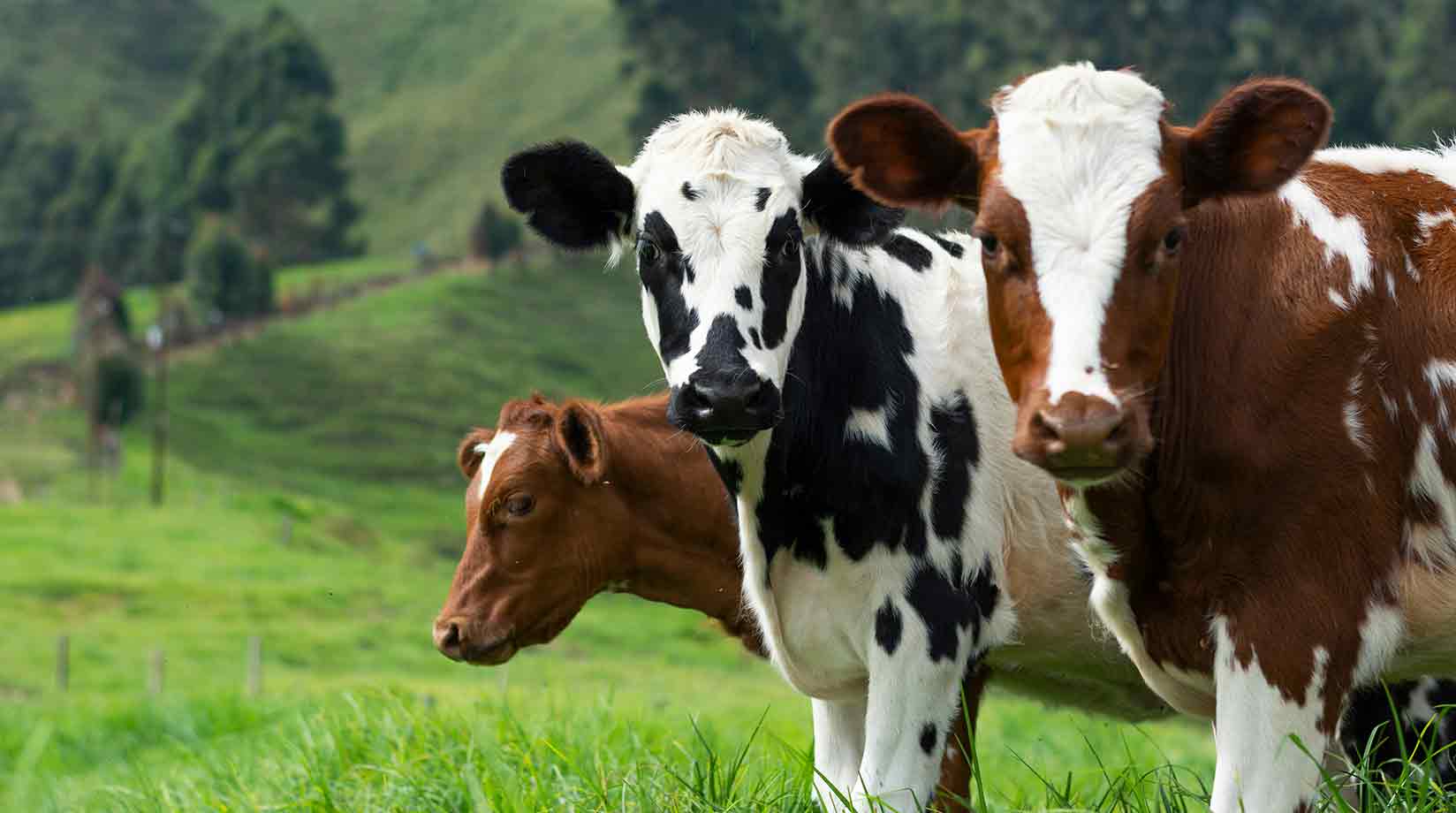
One of the most well-known cow breeds is the Holstein-Friesian, considered one of the best milk-producing cows in the world.14 It was imported to the US by Winthrop Chenery, a Massachusetts breeder.15 Other cows that are prized for their milk include the Jersey (light-brown cows originating in the island of Jersey in the English Channel) and the Guernsey (found widely across the US, UK and Australia).16
India is home to the world’s largest number of milk-producing cows, with more than 50 registered breeds.17
Of these, one of the most intriguing is the tiny Punganur dwarf cattle, which has a broad forehead, a prominent hump on its back, crescent-shaped horns, stubby legs and pointed ears.18 An indigenous breed native to the southern Indian state of Andhra Pradesh, Panganur cows are known for their abundant milk supply producing up to five litres a day. This milk is nutritionally rich, higher in fat and protein than the milk of many other breeds.19 Punganar cows are also efficient grazers, consuming far fewer resources than other cattle, which makes them a big hit with farmers.20
Another Indian breed, the Nelore, made global headlines when one cow reached the jaw-dropping price of $4.8 million at an auction in Brazil.21 The cow, named Viatina-19, weighed 1,088kg at the time of the auction. According to reports, her record-breaking price was due to her “exceptional growth, strong muscling and structural correctness”. 22
The sounds that a cow or bull makes is called a ‘low’, but is often referred to colloquially as a ‘moo’.23
Mooing can be high-pitched and intense, or low and gravelly like a moan. But this isn’t just barnyard babble. These are sounds that cows use to communicate.24 Researchers have found there are unique moos for different situations. For instance, when a cow is separated from her calf, her moos are loud and high-pitched, indicating deep distress. Studies have also shown that cows use mooing to help express complex emotions and can even identify one another based on their moos, just as we can recognise the voices of our loved ones.25
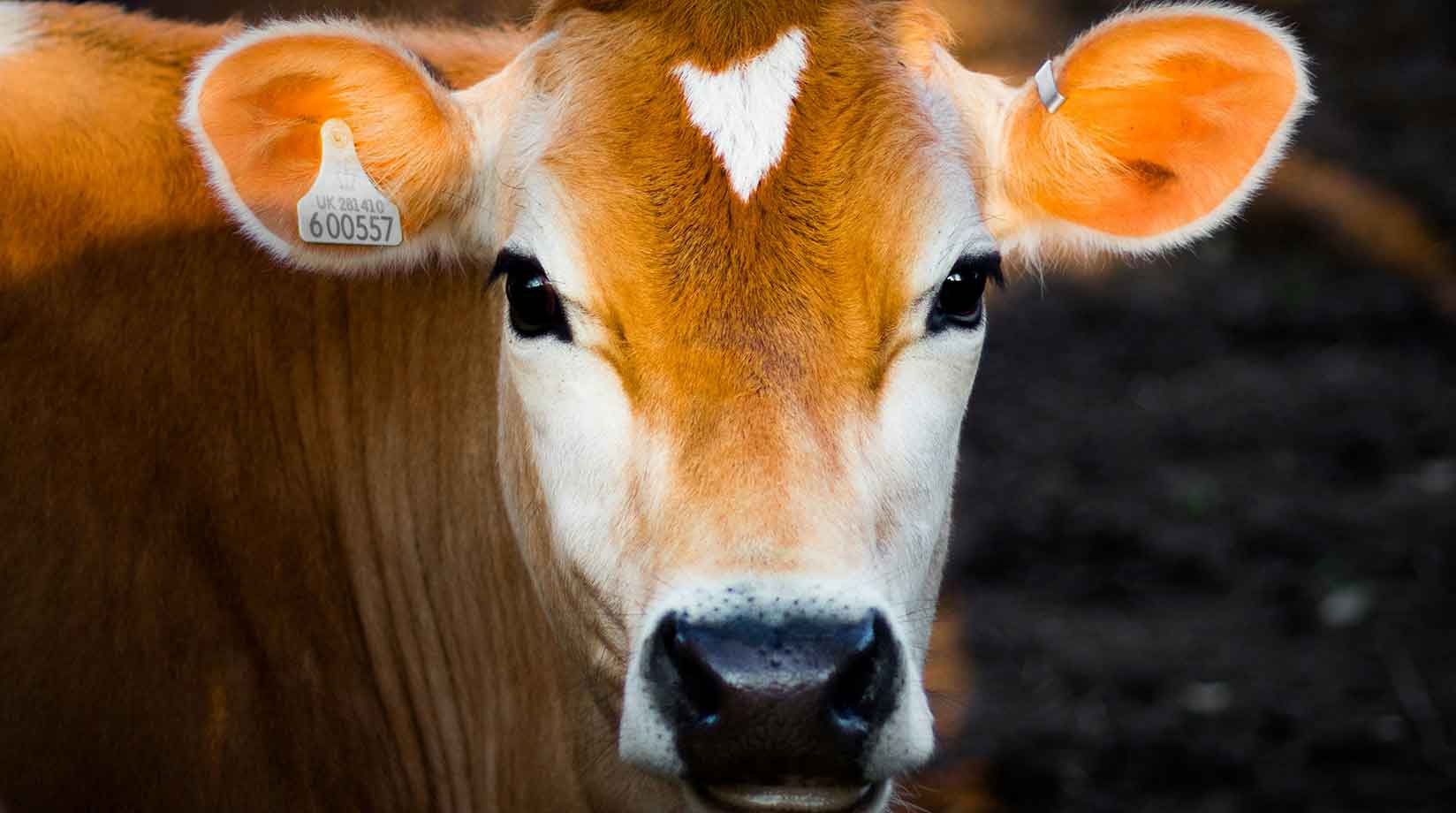
Yes, mature female cattle need to give birth before they can produce milk.26 To ensure a steady supply of milk to meet global dairy demand, farmed cows are often artificially inseminated, or encouraged to conceive naturally, around three months after giving birth to maintain a regular cycle of milk production.27 On average, farm-reared dairy cows give birth to one calf per year, producing their first offspring when they are roughly two years of age.28 Calves are often separated from their mothers within a day after birth – a practice known as early separation.29 Some studies suggest that bonding between the cow and calf intensifies after 24 hours. When separation occurs after this bond has formed, it can lead to increased anxiety in both animals. Cows and calves may vocalise more, show heightened activity and often attempt to reach out of their pens.30 Although early separation may reduce short-term distress, studies have shown that prolonged contact can have positive long-term effects on the calf.3
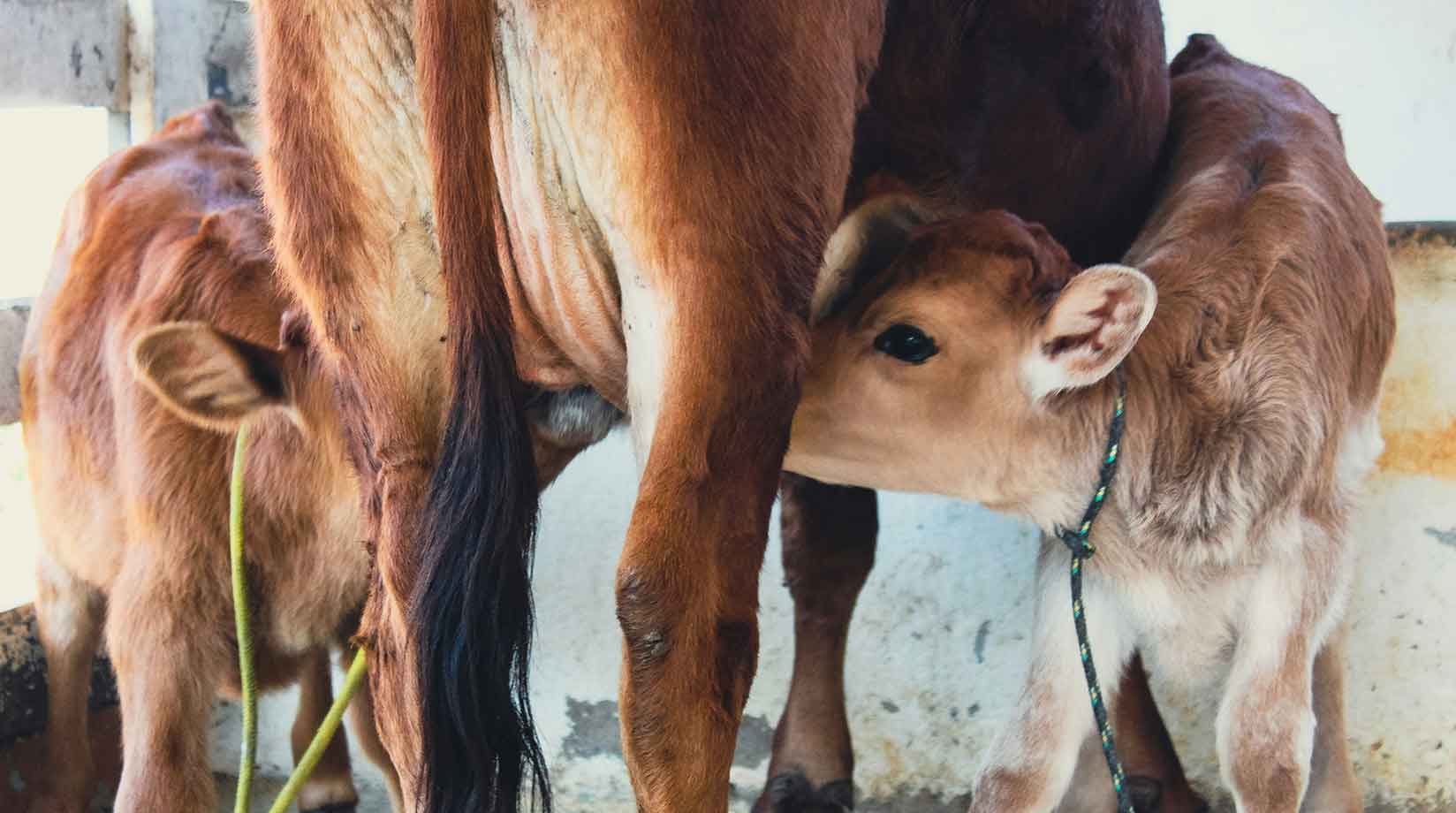
Cows typically sleep for four hours a day. One hour of this time is spent in REM (Rapid Eye Movement), a deep phase of sleep that is restorative.32 While the amount of time a cow sleeps might seem limited, a great deal of the day is spent lying down and resting.
Cows rest for nine to 11 hours each day for around an hour at a time, especially during the night. Studies have shown that lying down is very beneficial for a cow’s digestion and helps to increase milk production.33If time is limited, cows would choose to spend time lying down rather than eating.34 You can tell if a cow is asleep by the position of her head. During deep sleep, her head and neck will be motionless.35
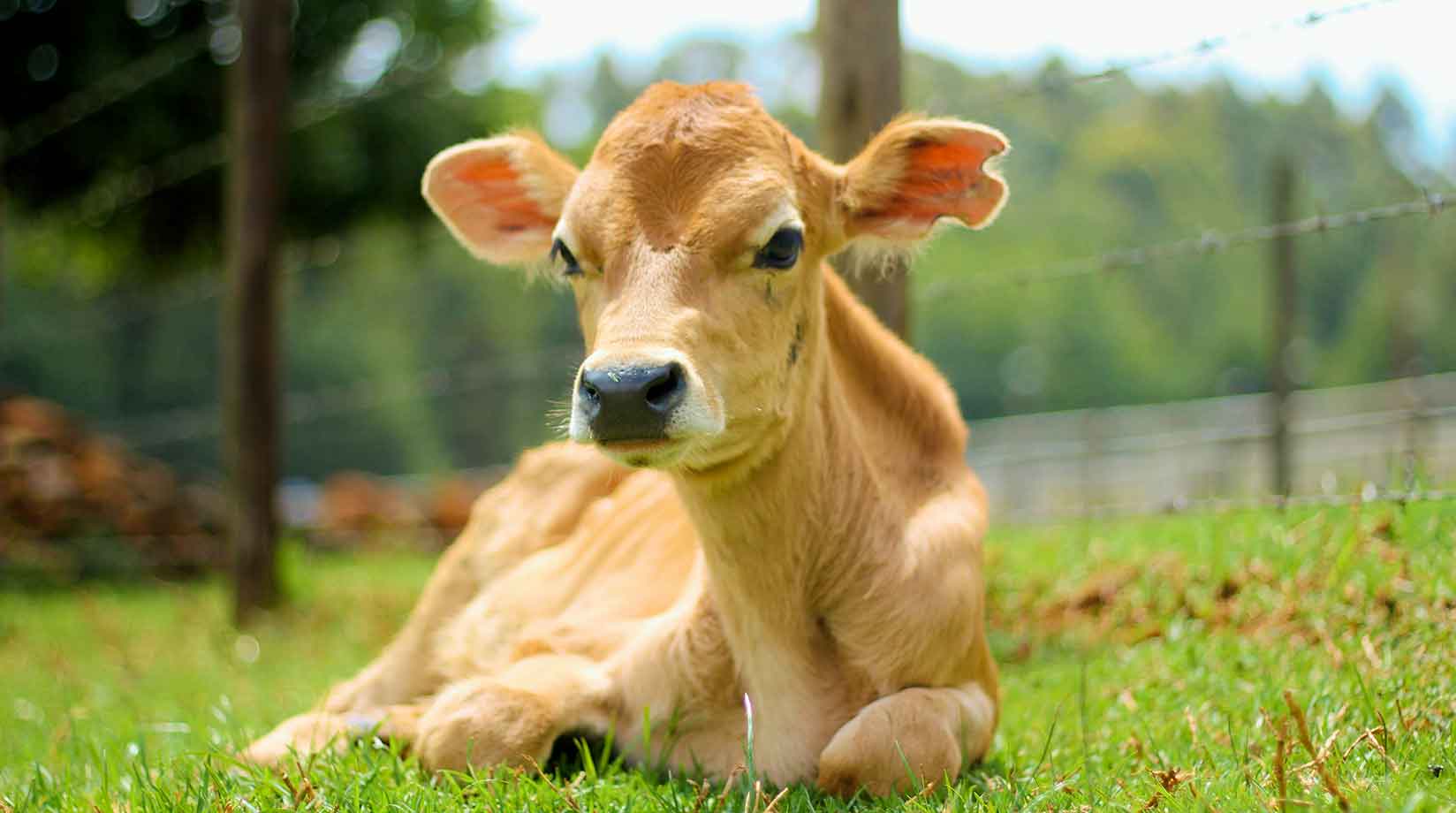
Researchers have observed that increasing global temperatures have impacted the sleep pattern of cows, affecting their health and milk productivity.36
A cow has only one stomach made up of four chambers, with each used in a different way to break down a cow's hard-to-digest diet of grass and vegetation.37 The first part of the stomach is the rumen. This is the largest chamber and can hold 95 litres of feed.38 The rumen has two main roles. It holds the chewed-up food and also acts as a fermentation vat, housing the many microbes used to break down food.39
From the rumen, the broken-down food is passed to the second chamber, the reticulum. This is a pouch-like structure that acts as a filter, separating the larger, more unwieldy pieces of food. The filtered food is passed into the third chamber or the omasum, which is made up of folded tissue that resembles the pages of a book. It’s the omasum’s job to absorb water before it passes into the fourth chamber. This is the abomasum and is often referred to as the “true stomach” as this is where the dietary proteins are digested and absorbed into the cow’s body.40
The fact that the rumen is home to hundreds of trillions of microbes has fascinated researchers. This microbiome, which is composed of bacteria, fungi and protozoa, is vital to the cow's health.41 One study established that a cow’s microbiome was extremely complex, colonised by over 339 microbes that could be ‘heritable’ or transmitted from parents to offspring.42 By studying the microorganisms that live in a cow’s stomach, researchers hope to improve cattle health and productivity. This could also have an added benefit for the environment.
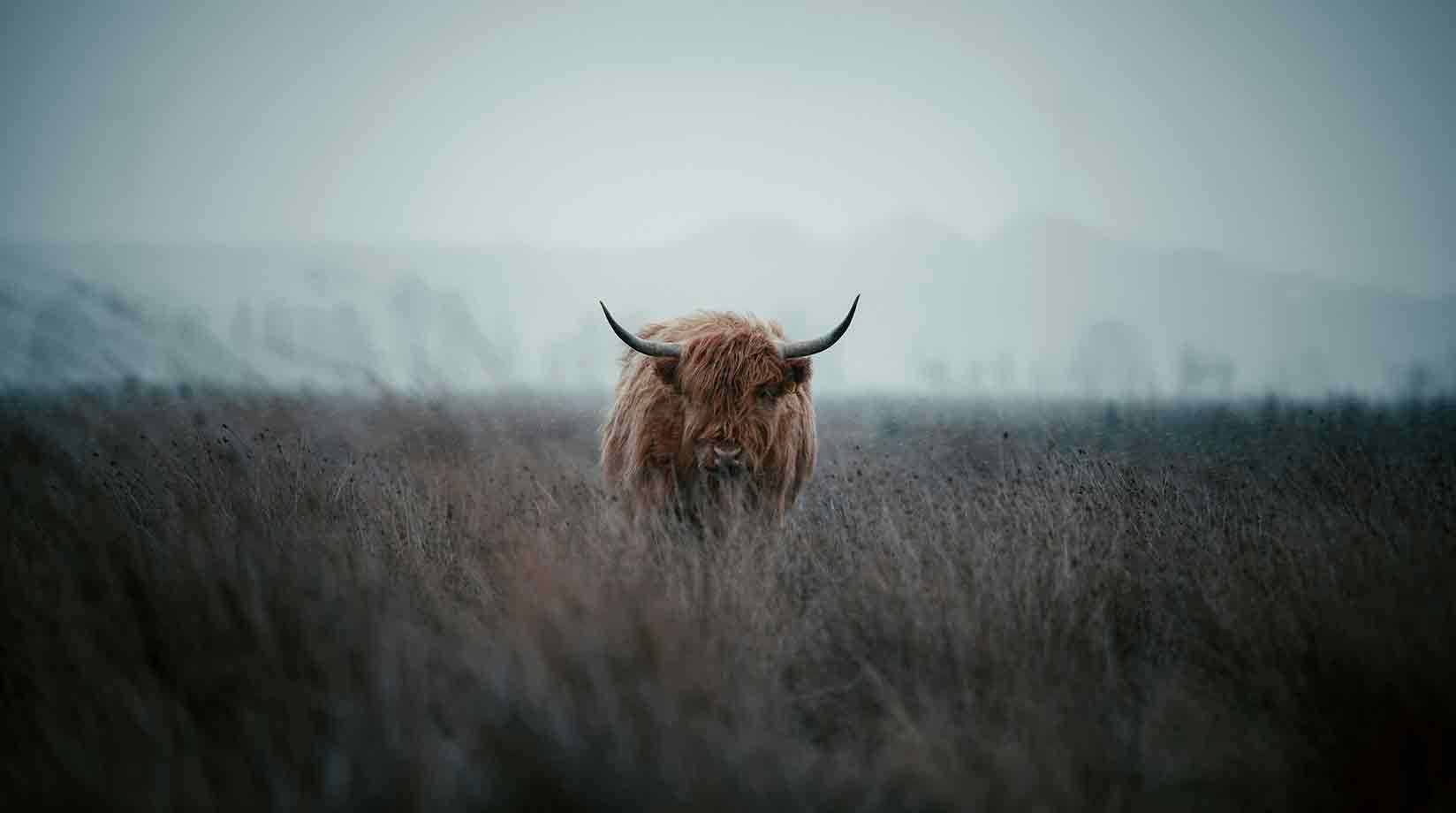
One microbe that cattle have in their rumen is called methanogen.43 This is the microbe that produces methane as a by-product of fermentation. The methane gas is then belched out by the cow which adds to the greenhouse gases that are already warming our planet.44 One area of study hopes to disrupt the methanogen’s methane production process using a vaccine, so less is released by the cow.45 Poor digestion can also increase a cow’s methane production, so changes in feed may also help to reduce how much a cow emits. Every year, a single cow belches an average of 99kg of methane.46
Dairy cows spend an average of eight hours a day chewing cud, which is regurgitated food.47 This amounts to 30,000 individual chews, and this is part of a process called rumination, which aids digestion.
During rumination, the chewed-up cud is stored in the first part of the stomach, the rumen. The stored food is brought back up and then chewed again, mixing with saliva to form a ball-like bolus. Cows swallow this bolus and then regurgitate it, repeating the process again and again. But this is not just idle chewing. Rumination makes food easier to digest by the microbes living in the cow’s stomach.48
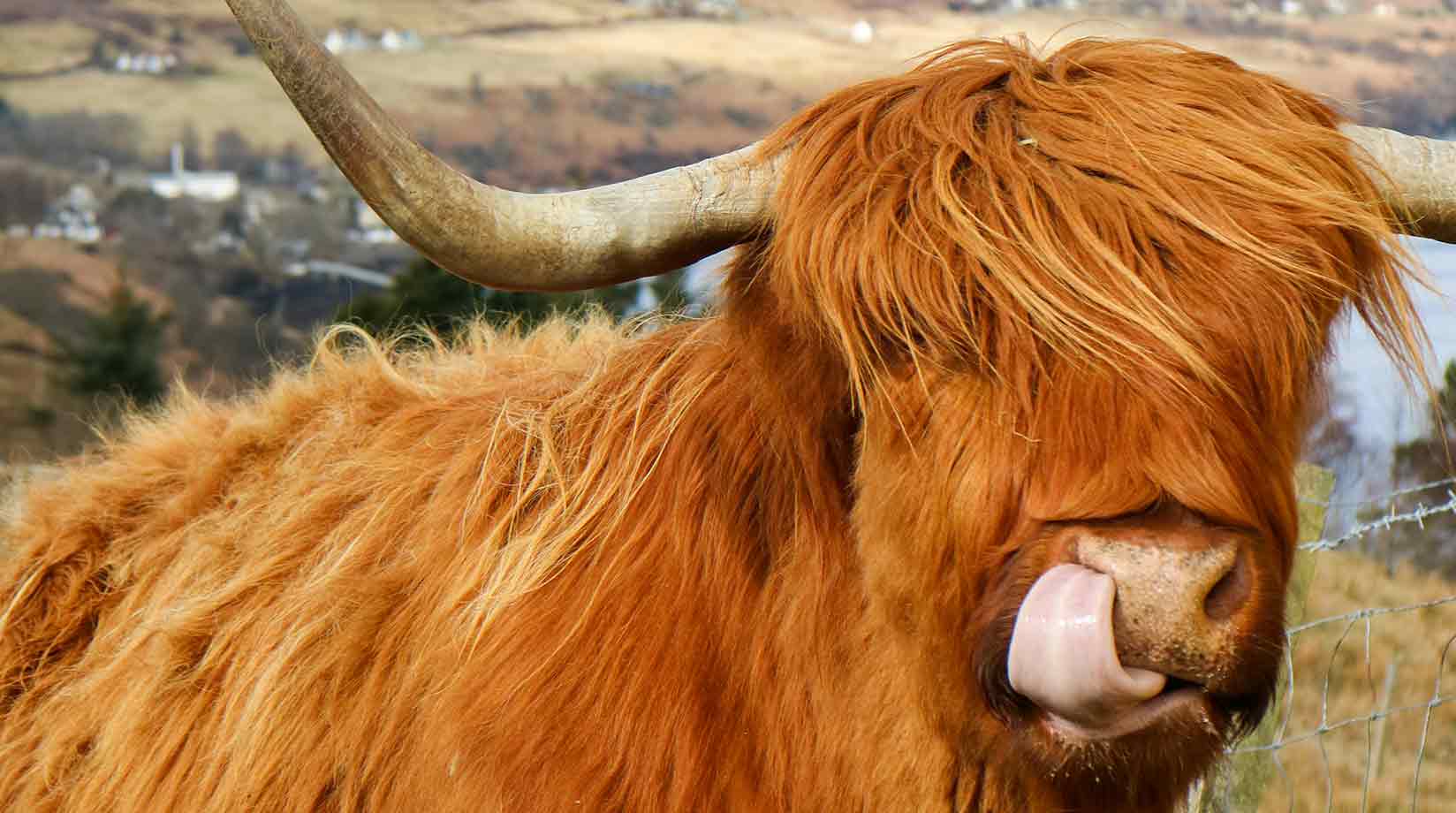
Cows and bulls are not naturally aggressive. External provocation or perceived threats can result in a spike of aggressive tendencies in cows and bulls.49 Aggressive traits may also crop up due to hormonal conditions. And while they don’t usually attack people, cows do have a tendency to fight among themselves, even more than bulls do.50 One reason bulls are considered more aggressive is down to the widely held belief that they charge at the sight of the colour red. However, this is just a myth. Cattle are, in fact, partially colour blind and red is one of the colours they can't see.51 When a bull charges at a matador’s cape, it's usually because it’s irritated by the movement of the material, rather than its bright colour.
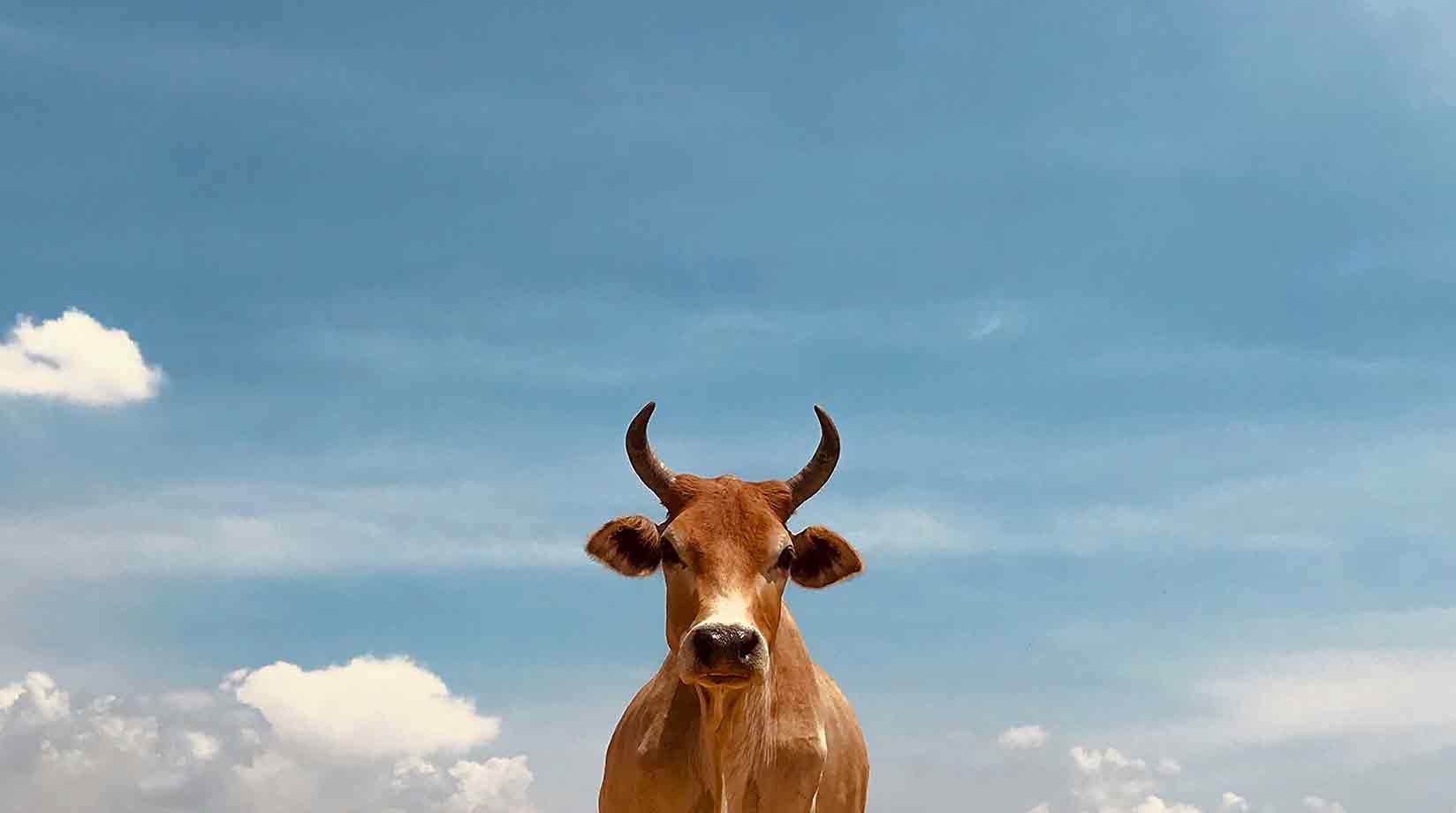
Cows have a keen sense of smell and can pick up scents from many miles away.52 They have even been known to enjoy the scent of coffee.53In a study carried out by researchers from Denmark in 2017, and published in the journal Applied Animal Behavior Science, it was established that cows had a powerful sense of smell that served them in many ways. The test was conducted on individual animals, and in the farms and homes where they were housed. Researchers worked with 10 cows and 13 heifers. Coffee, orange juice and odourless tap water were presented to each of these cows in a bucket. Each odour was presented twice in a row, for two minutes each. There was a pause of two minutes, allowing the cows to sniff it. Researchers recorded the cows’ reactions, observing how long they sniffed, and whether they licked or bit at the buckets.
They found that all animals sniffed at the coffee the longest, followed by orange juice. They showed the least interest in the odourless water. They licked and bit the buckets with the coffee the most, followed by the orange juice. The test showed that cows and heifers were able to distinguish between different complex odours and that they showed a clear preference to certain scents.
A cow’s sense of smell however does a lot more for it in its daily life – it influences its reproductive behaviour.A bull can detect if a cow is ready to mate or not based on a specific compound in the cow’s urine.54 The scent of a bull’s pheromones can induce puberty in heifers.5
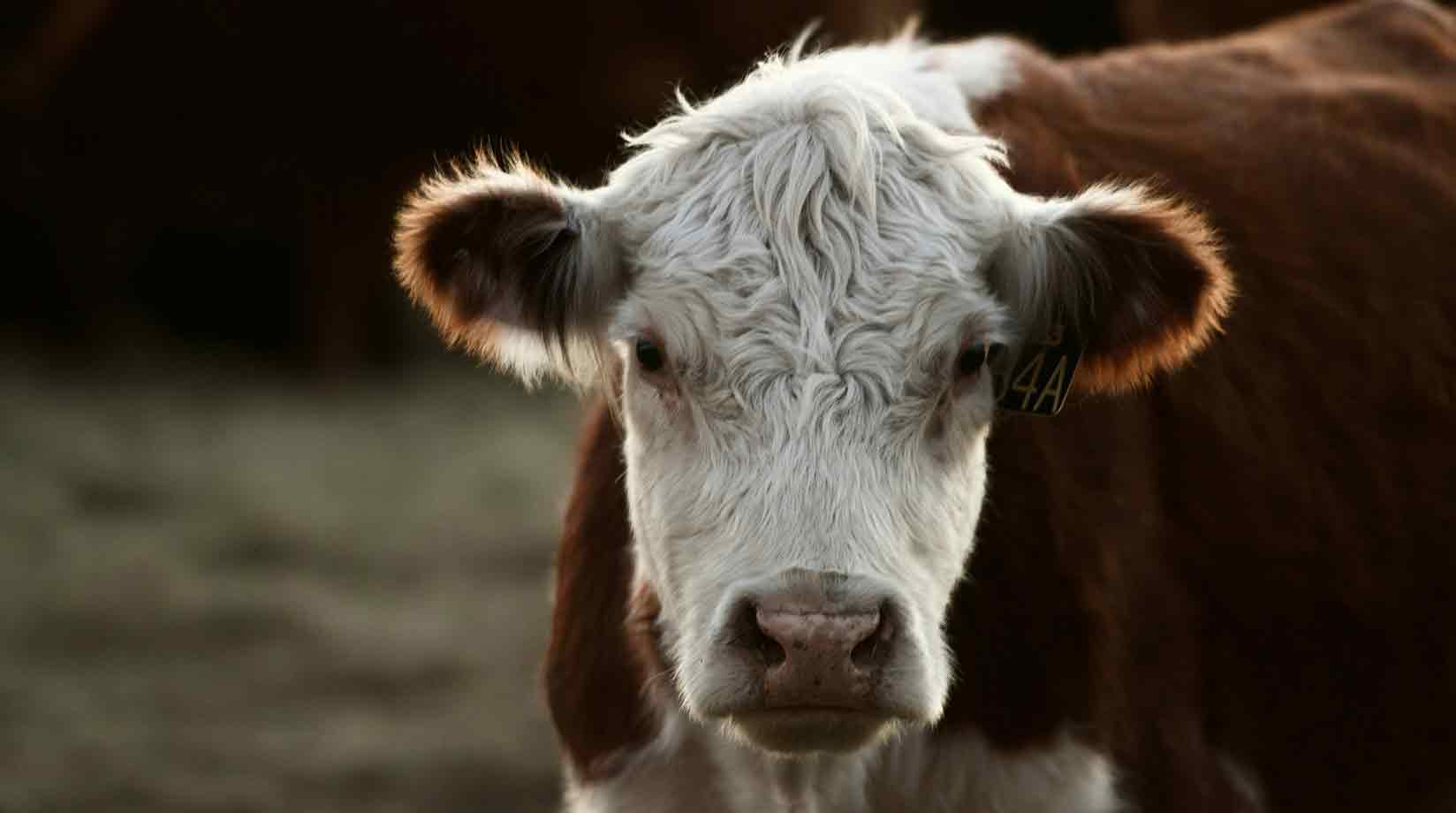
Cows are relatively friendly animals and research has shown that they have many traits that we humans can relate to. They play, have best friends among their herd and can be affectionate.56 These behaviours would suggest that they would be good pets.
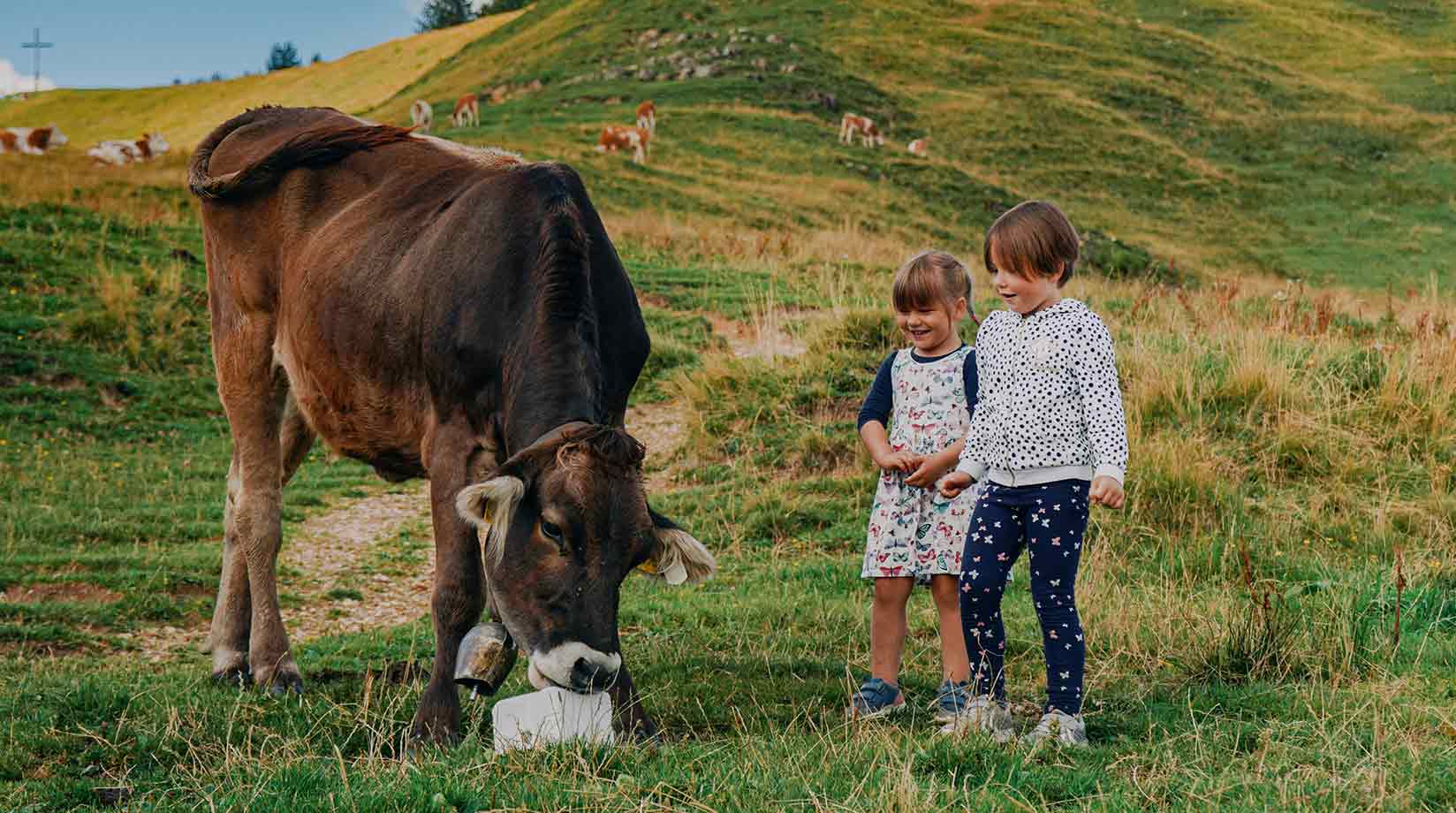
However, there are a number of reasons why keeping cows as pets is discouraged for most people, especially if you live in a city. Cows need lots of space and plenty of grass to graze on.57 They also need access to food, fresh water, and have to be kept in large barns or sheds that protect them from extreme weather. Cows are also social animals and tend to thrive when they live in herds.58 Keeping a single cow as a pet may not be a good idea but caring for several, if you have the space and the skills required, could be as rewarding as looking after cats or dogs.
Researchers say that tweaking a cow’s diet so that digestion is more efficient – such as adding more soya to their meals, replacing grass with maize or experimenting with probiotics – could be key to limiting methane emissions.59 One more unusual suggestion is a methane-collecting backpack. Scientists from Argentina’s National Institute of Agricultural Technology tried this back in 2008. They strapped balloon-like plastic bags onto the backs of cows to measure the extent of their flatulence and its impact on global warming.60 A tube attached through the skin to the animals’ stomachs collected the gas inside the backpack, which they were then able to measure. The results were quite surprising – a standard 550kg cow produced between 800 and 1,000 litres of emissions every day. This led the scientists to infer that as much as 30% of Argentina’s greenhouse gases could be caused by their 55 million cows.

Many farmers and ranchers are now adopting an agricultural approach called precision livestock farming (PLF), which involves the use of technology to monitor and manage livestock.61 This involves reducing waste, greenhouse gas emissions and making efficient use of resources. Cattle wear sensors to track their vital signs, movement and behaviour in real-time, helping farmers to detect health issues early, improve their breeding, optimise milk output, all while monitoring their digestion closely to regulate their impact on the environment.
Yes, it seems they do! Studies have established that relaxing melodies may have a positive effect on cattle, as long as they are interspersed with periods of silence.62
Two music researchers, Adrian North and Liam MacKenzie, from the University of Leicester in the UK, put this theory to the test by playing two different kinds of music to 1,000 Holstein-Friesian cattle. Some cattle were exposed to fast-paced music of 120 beats per minute, others to slower melodies under 100bpm, while a final group experienced no music at all. The results indicated that the cows who heard music such as Beethoven’s ‘Pastoral Symphony’ or Simon & Garfunkel’s ‘Bridge over Troubled Water’ yielded 3% more milk than those exposed to faster-paced music such as Bananarama’s song ‘Venus’. They also detected a small decline in milk production from those cows who experienced excessively loud music.63
Studies have established that relaxing melodies may have a positive effect on cattle, as long as they are interspersed with periods of silence.
Cows are not an endangered species. However, there are some rare breeds whose numbers are limited, such as the Panganur cow. In 2012, there were only 2,000 of these miniature cows left in India, prompting scientists to find ways to keep this endangered breed alive.64 One method the Indian government tried to improve numbers was surrogacy. A hundred healthy and mature Panganur cows were identified as embryo donors, and 25 viable embryos were produced each year.65This seems to have had an effect, as a survey in 2022 revealed that numbers had grown to 8,806 cows.66
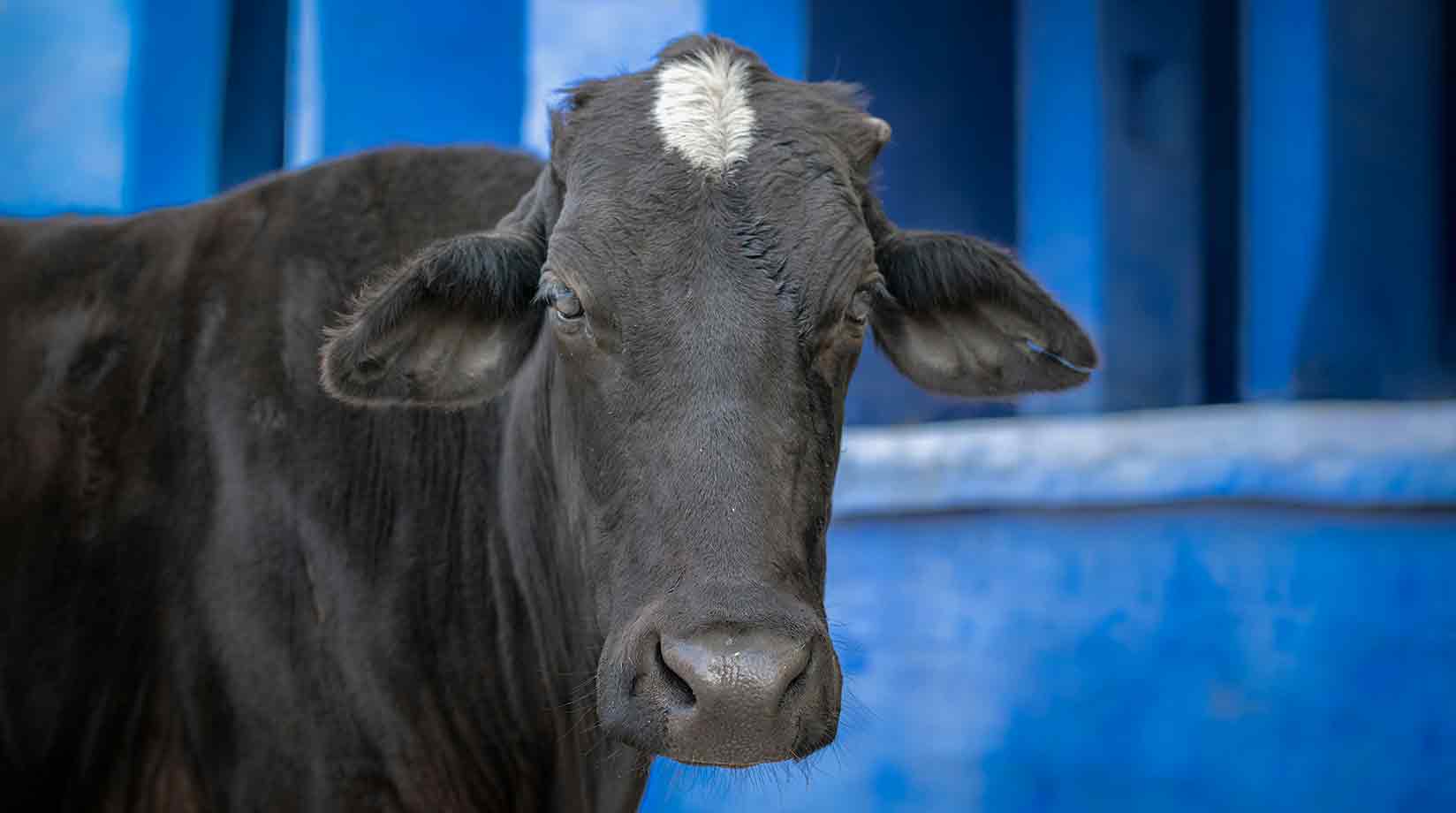
It’s not always possible to revive a dying breed. Pineywoods is one of the oldest cattle breeds in the southeastern United States. These speckled brown and white cows with handlebar horns are now in danger of extinction as a result of excessive crossbreeding.67 Each crossbreed, while healthy, had its own distinctive traits and characteristics that made it very different from the parent breed. As a result, only 12 purebred Pineywoods are left.68
Yes, cows do have predators. In the wild, cattle can be attacked by wolves, spotted hyenas, lions, leopards, tigers and grizzly bears.69
Death loss statistics issued by the United States’ Department of Agriculture indicates that more calves are lost to predators than adult cattle.70 A rise in the predation of cattle by wolves at Yellowstone National Park in the US. has been a cause for concern and conflict.71 Ranchers have complained that livestock management around the park has been increasingly challenging, ever since the wolf population grew.72
As a response to fear, threats from predators and even general stress and anxiety, cows rely on a technique called “bunching”, where they recognise danger and close ranks.73 Bunching begins when a dominant cow directs three or four others to form a close-knit group. Slowly, this stress and apprehension spreads to other members of the herd who start bunching as well. When faced with a predator in the wild, this technique helps the herd protect their vulnerable calves.74 Cows even have the innate ability to bunch when they’ve been raised on farms.
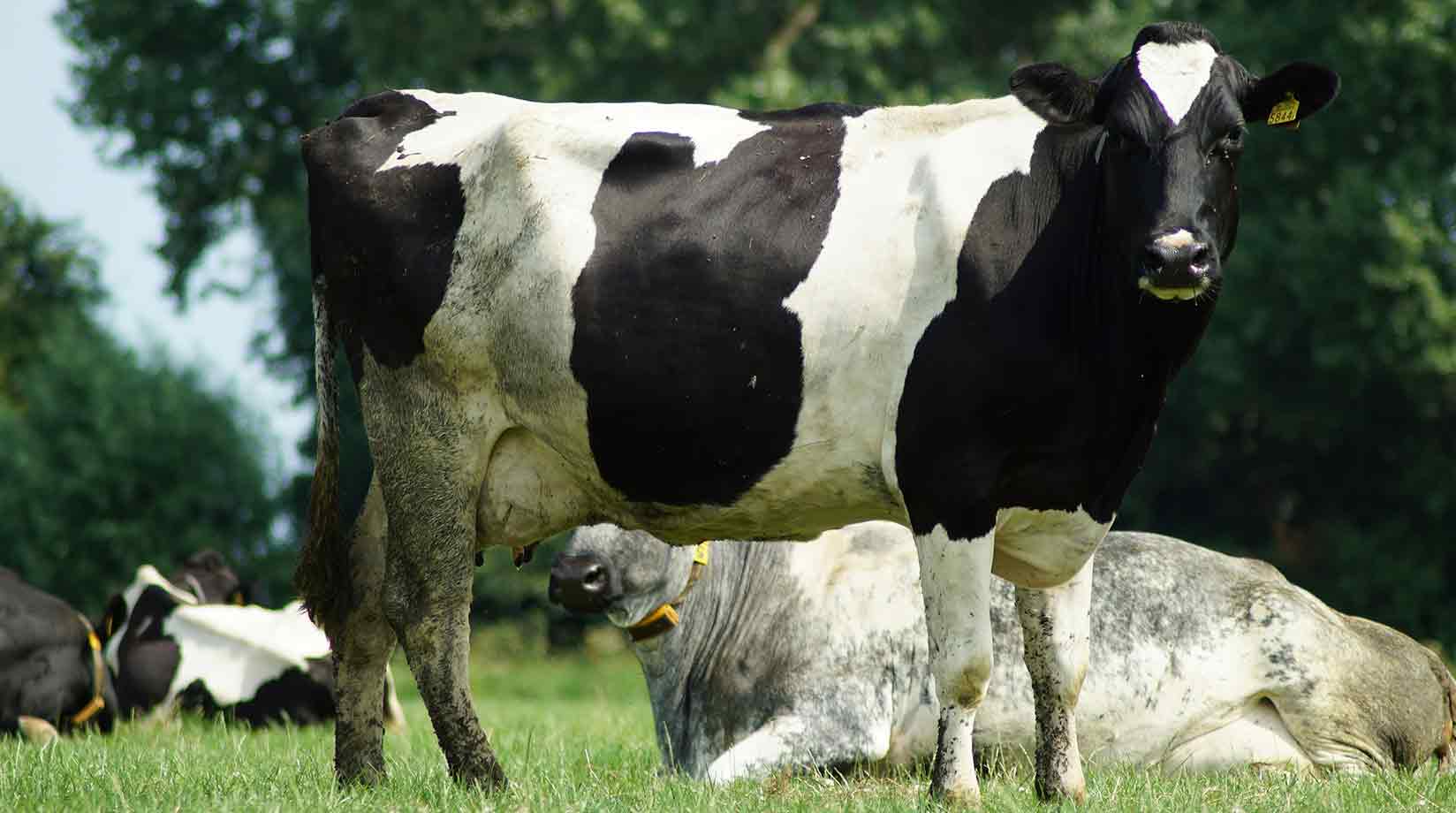
Ranchers are always alert to any signs of bunching as it can compromise a cow’s health and well-being, increasing stress and resulting in a loss of milk production.75
Despite their weight and size, cows are natural swimmers. That’s because they have a long body and short legs, which provides them with natural buoyancy. They also have powerful leg muscles that can carry them for miles in the water.76 On a farm beside Strangford Lough, the largest inlet in Northern Ireland, cows have to swim across the waters every year to get to the greener pastures on the other side.77
Necessity aside, cows do not swim unless they absolutely have to. Instead, they tend to prefer wet, low-lying areas and, given the opportunity, will wade into shallow water on a hot day.
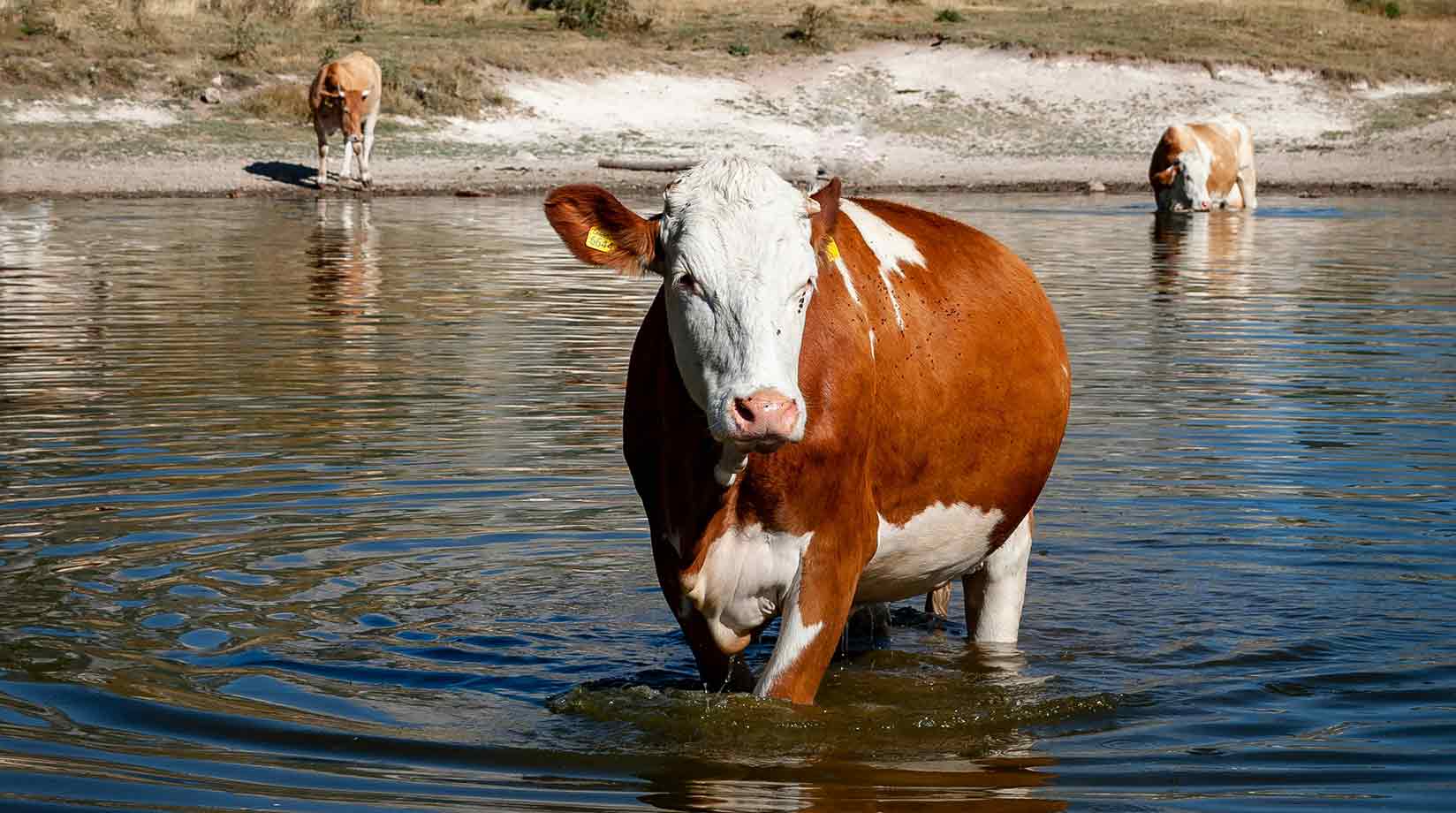
Featured image © Jonas Koel | Unsplash
Fun fact image © Subtle Cinematics | Unsplash
Quick facts:
1. “What Eats Team, “What Eats a Cow?,” What Eats What?, October 8, 2024, https://whateats.com/what-eats-a-cow; Bernard M. Kissui, Department of Ecology, Evolution & Behavior, University of Minnesota, “Livestock predation by lions, leopards, spotted hyenas, and their vulnerability to retaliatory killing in the Maasai steppe, Tanzania https://cbs.umn.edu/sites/cbs.umn.edu/files/migrated-files/downloads/Ki…
2. Understanding Animal Research. “Cattle,” Accessed March 16, 2025, https://www.understandinganimalresearch.org.uk/using-animals-in-scienti…
3. ANN BIGGS OF GCI. “Cattle Factsheet,” n.d. https://education.rspca.org.uk/documents/1494931/0/FS+Cattle+Factsheet…
4. “Vechur | Dairy Knowledge Portal,” n.d. https://www.dairyknowledge.in/dkp/article/vechur; “Chianina,” n.d., https://www.thecattlesite.com/breeds/beef/44/chianina
5. Britannica Kids. “Cattle,” n.d. https://kids.britannica.com/kids/article/cattle/352928
6) World Animal Protection US. “Cow Facts,” n.d. https://www.worldanimalprotection.us/education/animal-facts/cow-facts/#…
7. “Cattle Population by Country 2024,” n.d. https://worldpopulationreview.com/country-rankings/cattle-population-by…;
8. Statista. “Cattle Population Worldwide 2012-2022,” August 9, 2024. https://www.statista.com/statistics/263979/global-cattle-population-sin…
9. Base. “Wondering How Many Cows Are in the World? Global Cattle Population Data Revealed! | Farms.com.” Copyright 2007 by My Website, n.d. https://m.farms.com/news/wondering-how-many-cows-are-in-the-world-globa…
10. Smithsonian’s National Zoo and Conservation Biology Institute. “Cow,” n.d. https://nationalzoo.si.edu/animals/cow.
11. IUCN Red List of Threatened Species. “The IUCN Red List of Threatened Species,” n.d. https://www.iucnredlist.org/search?query=cows%20&searchType=specie.
12. Rao, G Venkataraman. “Scientists Launch Study to Help Punganur Cow Back on Its Knees.” The Hindu, December 13, 2018 https://www.thehindu.com/news/cities/Vijayawada/scientists-launch-study…
Fact File:
1. Holmes, Matilda, Helena Hamerow, and Richard Thomas. “Close Companions? A Zooarchaeological Study of the Human–Cattle Relationship in Medieval England.” Animals 11, no. 4 (April 20, 2021): 1174. https://doi.org/10.3390/ani11041174
2. Madden, Robert, “The Development of Agriculture,” National Geographic, n.d. https://education.nationalgeographic.org/resource/development-agricultu…
3. Statista. “Number of Milk Cows Worldwide by Country 2023 | Statista,” October 10, 2023. https://www.statista.com/statistics/869885/global-number-milk-cows-by-c…
4. O’Brien, D. (2010, January 12). Teagasc guidelines to follow when calculating an animal’s water need. Irish Independent. https://www.independent.ie/business/farming/teagasc-guidelines-to-follo…
5. Applied Animal Behaviour Science, Volume 196, Pages 84-90, Maria Vilain Rørvang, Margit Bak Jensen, Birte Lindstrøm Nielsen, Development of test for determining olfactory investigation of complex odours in cattle, 2017 https://doi.org/10.1016/j.applanim.2017.07.008
6. Science Questions With Surprising Answers. “What Is It About Red That Makes Bulls so Angry?,” December 12, 2012. https://www.wtamu.edu/~cbaird/sq/2012/12/12/what-is-it-about-red-that-m…
7. Cooper, M. (2001, June 27). Moosic to their ears. New Scientist. https://www.newscientist.com/article/dn930-moosic-to-their-ears/.
8. Machado, T. M. P., Filho, L. C. P. M., Daros, R. R., Machado, G. T. B. P., & Hötzel, M. J. (2020). Licking and agonistic interactions in grazing dairy cows as indicators of preferential companies. Applied Animal Behaviour Science, 227, 104994. https://doi.org/10.1016/j.applanim.2020.104994
9. De La Torre, M. P., Briefer, E. F., Ochocki, B. M., McElligott, A. G., & Reader, T. (2016). Mother–offspring recognition via contact calls in cattle, Bos taurus. Animal Behaviour, 114, 147–154. https://doi.org/10.1016/j.anbehav.2016.02.004
10. The Editors of Encyclopaedia Britannica. “Aurochs | Wild, Wild Ox, Bovine.” Encyclopedia Britannica, February 24, 2025. https://www.britannica.com/animal/aurochs
11. Rawat, Roween. “From Aurochs to Burgers.” Natural History Museum, n.d. https://www.nhm.ac.uk/discover/from-aurochs-to-burgers.html
12. Buchanan, David. (2016). Breeds of Dairy Cattle (Major Bos taurus Breeds). 10.1016/B978-0-08-100596-5.00624 https://www.researchgate.net/publication/301263416_Breeds_of_Dairy_Catt…
13. Marleen Felius (September 2007). Cattle Breeds: An Encyclopedia. Trafalgar Square Publishing. ISBN 978-1-57076-381-6.
14. “Dairy Cattle Breeds | Milk Production, Domestication, List, & Facts | Britannica.” Encyclopædia Britannica, 2024, www.britannica.com/topic/dairy-cattle-breeds
15. Melissa Elischer, Michigan State University Extension. “History of Dairy Cow Breeds: Holstein.” MSU Extension, December 26, 2014. https://www.canr.msu.edu/news/history_of_dairy_cow_breeds_holstein
16. ———. “Jersey | Milk Production, Dairy Farming & Livestock.” Encyclopedia Britannica, January 20, 2025. https://www.britannica.com/animal/Jersey-breed-of-cattle; ———. “Guernsey | Dairy, Brown, Hardy.” Encyclopedia Britannica, July 28, 1999. https://www.britannica.com/animal/Guernsey-breed-of-cattle
17. Registered Cattle - ICAR- National Bureau of Animal Genetic Resources. (2024b, February 20). ICAR- National Bureau of Animal Genetic Resources. https://nbagr.icar.gov.in/en/registered-cattle/
18. Punganur | Dairy Knowledge Portal. (n.d.). https://www.dairyknowledge.in/dkp/article/punganur
19. “Punganur Cows.” 2024. PMF IAS. January 28, 2024. https://www.pmfias.com/punganur-cows-2/; “Feeding Practices of Punganur Cows Adopted by the Farmers in Four Mandals of Chittoor District of Andhra Pradesh.” The Pharma Innovation Journal. Vol. SP-11–5, 2022. https://www.thepharmajournal.com/archives/2022/vol11issue5S/PartK/S-11-…
20. ThemeMascot. “Punganur Cows - ACQ IAS Academy.” ACQ IAS, n.d. https://acqias.com/daily-news-analysis-current-affairs/Punganur-cows
21. ET Online. 2024. “Record-Breaking Nelore Cow Sold for 40 Crores in Brazil Sets New Livestock Auction Milestone.” The Economic Times. Economic Times. March 26, 2024. https://economictimes.indiatimes.com/news/india/record-breaking-nelore-…
22. ---“World’s Most Expensive Cow Sold for $4.8 Million.” The Times of India, February 9, 2025. https://timesofindia.indiatimes.com/etimes/trending/worlds-most-expensi….
23. Stand out from the herd: how cows commooonicate through their lives. (2019, December 19). The University of Sydney. https://www.sydney.edu.au/news-opinion/news/2019/12/19/stand-out-from-h…
24. Lisa Bohler, “7 Reasons Why Cows Moo and What Each Pitch Means,” AZ Animals, n.d https://a-z-animals.com/blog/7-reasons-cows-moo-and-what-each-pitch-mea…
25. *BBC News. “Cow Researchers Find Meanings Behind Moos,” December 16, 2014. https://www.bbc.com/news/uk-england-nottinghamshire-30484034
26. Hussain, Grace. “Do Cows Have to Be Pregnant to Produce Milk and Do They Feel Pain When Milked?” Sentient, October 24, 2022. https://sentientmedia.org/do-cows-have-to-be-pregnant-to-produce-milk
27. Compassion USA. “About Dairy Cows,” n.d. https://www.ciwf.com/farmed-animals/cows/dairy-cows
28. RSPCA. “Dairy Cow Welfare | RSPCA - RSPCA - rspca.org.uk,” n.d. https://www.rspca.org.uk/adviceandwelfare/farm/dairy
29. Ilona Stěhulová, Lena Lidfors, Marek Špinka, Response of dairy cows and calves to early separation: Effect of calf age and visual and auditory contact after separation, Applied Animal Behaviour Science,Volume 110, Issues 1–2, 2008, Pages 144-165, ISSN 0168-1591, https://doi.org/10.1016/j.applanim.2007.03.028 (https://www.sciencedirect.com/science/article/pii/S0168159107001220 )
30. Ilona Stěhulová, Lena Lidfors, Marek Špinka, Response of dairy cows and calves to early separation: Effect of calf age and visual and auditory contact after separation, Applied Animal Behaviour Science,Volume 110, Issues 1–2, 2008, Pages 144-165, ISSN 0168-1591, https://doi.org/10.1016/j.applanim.2007.03.028 (https://www.sciencedirect.com/science/article/pii/S0168159107001220 )
31. R.K. Meagher, A. Beaver, D.M. Weary, M.A. von Keyserlingk Invited review: A systematic review of the effects of prolonged cow–calf contact on behavior, welfare, and productivity, J. Dairy Sci., 102 (2019), pp. 5765-5783, 10.3168/jds.2018-16021 https://www.sciencedirect.com/science/article/pii/S0022030219304369
32. “Are Your Cows Getting Enough Sleep Each Night? | Animal & Food Sciences,” n.d. https://afs.ca.uky.edu/content/are-your-cows-getting-enough-sleep-each-…
33. McWilliams, C. J., Schwanke, A. J., & DeVries, T. J. (2021). Is greater milk production associated with dairy cows who have a greater probability of ruminating while lying down? JDS Communications, 3(1), 66–71. https://doi.org/10.3168/jdsc.2021-0159
34. “Are Your Cows Getting Enough Sleep Each Night? | Animal & Food Sciences,” n.d. https://afs.ca.uky.edu/content/are-your-cows-getting-enough-sleep-each-…
35. " “Do Cows Need Beauty Rest Too?,” n.d. https://www.thecattlesite.com/articles/4175/do-cows-need-beauty-rest-to…
36. “Impact of Heat Stress on Health and Performance of Dairy Animals: A Review,” n.d. https://www.veterinaryworld.org/Vol.9/March-2016/7.html
37. T. J. Hackmann1 Department of Animal Sciences, University of Florida, Strategies to Improve Rumen Microbial Efficiency, https://animal.ifas.ufl.edu/apps/dairymedia/rns/2014/hackmann.pdf
38. The ruminant digestive system. (n.d.). https://extension.umn.edu/dairy-nutrition/ruminant-digestive-system
39. T. J. Hackmann1 Department of Animal Sciences, University of Florida, Strategies to Improve Rumen Microbial Efficiency https://animal.ifas.ufl.edu/apps/dairymedia/rns/2014/hackmann.pdf
40. The ruminant digestive system. (n.d.). https://extension.umn.edu/dairy-nutrition/ruminant-digestive-system
41. Cammack, K M, K J Austin, W R Lamberson, G C Conant, and H C Cunningham. “Tiny but Mighty: The Role of the Rumen Microbes in Livestock Production.” Journal of Animal Science, January 27, 2018. https://doi.org/10.1093/jas/skx053
42. Wallace RJ, Sasson G, Garnsworthy PC, Tapio I, Gregson E, Bani P, Huhtanen P, Bayat AR, Strozzi F, Biscarini F, Snelling TJ, Saunders N, Potterton SL, Craigon J, Minuti A, Trevisi E, Callegari ML, Cappelli FP, Cabezas-Garcia EH, Vilkki J, Pinares-Patino C, Fliegerová KO, Mrázek J, Sechovcová H, Kopečný J, Bonin A, Boyer F, Taberlet P, Kokou F, Halperin E, Williams JL, Shingfield KJ, Mizrahi I. A heritable subset of the core rumen microbiome dictates dairy cow productivity and emissions. Sci Adv. 2019 Jul 3;5(7):eaav8391. doi: 10.1126/sciadv.aav8391. PMID: 31281883; PMCID: PMC6609165. https://www.science.org/doi/10.1126/sciadv.aav8391
43. Hook, Sarah E., André-Denis G. Wright, and Brian W. McBride. “Methanogens: Methane Producers of the Rumen and Mitigation Strategies.” Archaea 2010 (January 1, 2010): 1–11. https://doi.org/10.1155/2010/945785
44. CLEAR Center. “Why Do Cattle Produce Methane, and What Can We Do About It?,” April 22, 2024. https://clear.ucdavis.edu/explainers/why-do-cattle-produce-methane-and-…
45. Baca-González, Victoria, Patricia Asensio-Calavia, Sergio González-Acosta, Jose Manuel Pérez De La Lastra, and Antonio Morales De La Nuez. “Are Vaccines the Solution for Methane Emissions From Ruminants? A Systematic Review.” Vaccines 8, no. 3 (August 20, 2020): 460. https://doi.org/10.3390/vaccines8030460
46. UC Davis. “Cows and Climate Change,” January 7, 2025. https://www.ucdavis.edu/food/news/making-cattle-more-sustainable
47. K.A. Beauchemin, Journal of Dairy Science,Volume 101, Issue 6, Pages 4762-4784 “Why Do Cattle Chew Their Cud? | Animal & Food Sciences,” 2018, https://afs.ca.uky.edu/content/why-do-cattle-chew-their-cud., https://doi.org/10.3168/jds.2017-13706.
48. K.A. Beauchemin, Invited review: Current perspectives on eating and rumination activity in dairy cows, Journal of Dairy Science,Volume 101, Issue 6, 2018, Pages 4762-4784, https://www.sciencedirect.com/science/article/pii/S0022030218303023
49. Landsberg, Gary M., and Sagi Denenberg. “Behavioral Problems of Cattle.” MSD Veterinary Manual, May 27, 2014. https://www.msdvetmanual.com/behavior/normal-social-behavior-and-behavi…
50. Landsberg, Gary M., and Sagi Denenberg. “Behavioral Problems of Cattle.” MSD Veterinary Manual, May 27, 2014. https://www.msdvetmanual.com/behavior/normal-social-behavior-and-behavi…
51. Borel, B. (2012, February 6). Why Do Bulls Charge When they See Red? livescience.com. https://www.livescience.com/33700-bulls-charge-red.html
52. BC SPCA. “10 Fun Facts About Cows - BC SPCA,” January 8, 2025. https://spca.bc.ca/news/fun-facts-about-cows
53. Applied Animal Behaviour Science, Volume 196, Pages 84-90, Maria Vilain Rørvang, Margit Bak Jensen, Birte Lindstrøm Nielsen, Development of test for determining olfactory investigation of complex odours in cattle, 2017 https://doi.org/10.1016/j.applanim.2017.07.008
54. Archunan, Govindaraju, Swamynathan Rajanarayanan, and Kandasamy Karthikeyan. “Cattle Pheromones.” Neurobiology of Chemical Communication - NCBI Bookshelf, 2014. https://www.ncbi.nlm.nih.gov/books/NBK200988
55. Archunan, Govindaraju, Swamynathan Rajanarayanan, and Kandasamy Karthikeyan. “Cattle Pheromones.” Neurobiology of Chemical Communication - NCBI Bookshelf, 2014. https://www.ncbi.nlm.nih.gov/books/NBK200988
56. Millstein, Seth. “Cows Play and Have Best Friends — but Are Rarely Given the Chance.” Sentient, January 9, 2024. https://sentientmedia.org/do-cows-play
57. Miles, Daniel. “Would You Adopt a Cow? Farm Animals Deemed Surplus to Industry Needs Rehomed as Backyard Pets.” ABC News, July 20, 2023. https://www.abc.net.au/news/2023-07-14/adopt-a-cow-and-other-farm-anima…
58. Huxley, Jon N. and University of Nottingham. “Cattle Behavior and Implications to Performance and Health,” n.d. https://animal.ifas.ufl.edu/apps/dairymedia/rns/2010/6-Huxley.pdf
59. US EPA. “Sources of Greenhouse Gas Emissions | US EPA,” July 8, 2024. https://www.epa.gov/ghgemissions/sources-greenhouse-gas-emissions; CLEAR Center. “Why Do Cattle Produce Methane, and What Can We Do About It?,” April 22, 2024. https://clear.ucdavis.edu/explainers/why-do-cattle-produce-methane-and-….
60. Cow Backpacks Trap Methane Gas. (2008, July 11). https://phys.org/news/2008-07-cow-backpacks-methane-gas.html
61. Parisa Niloofar, Deena P. Francis, Sanja Lazarova-Molnar, Alexandru Vulpe, Marius-Constantin Vochin, George Suciu, Mihaela Balanescu, Vasileios Anestis, Thomas Bartzanas, Data-driven decision support in livestock farming for improved animal health, welfare and greenhouse gas emissions: Overview and challenges, Computers and Electronics in Agriculture, 2021, https://doi.org/10.1016/j.compag.2021.106406
62. Ciborowska, P., Michalczuk, M., & Bień, D. (2021). The Effect of Music on Livestock: Cattle, Poultry and Pigs. Animals, 11(12), 3572. https://doi.org/10.3390/ani11123572
63. Cooper, M. (2001, June 27). Moosic to their ears. New Scientist. https://www.newscientist.com/article/dn930-moosic-to-their-ears/
64. M. Kalyana Chakravarthi, G. Alexander Sri Venkateswara, “Performance of Miniature Panganur Catte of Andhra Praesh, India, Ekambaram Veterinary University (2017) https://www.semanticscholar.org/paper/PERFORMANCE-OF-MINIATURE-PUNGANUR…
65. Rangarajan, A.D. “Surrogacy, Key to Reviving Endangered Punganur Cows.” The Hindu, October 30, 2020. https://www.thehindu.com/news/national/andhra-pradesh/surrogacy-key-to-…
66. Sharma, Harikishan. (2024, January 16). Meet the Panganur Dwarf Cows that PM Modi Fed on Makar Sankranti. https://indianexpress.com/article/explained/punganur-cows-modi-9111523/
67. Angelique. “Pineywoods Cattle - the Livestock Conservancy.” The Livestock Conservancy, March 21, 2023. https://livestockconservancy.org/heritage-breeds/heritage-breeds-list/p…
68. Pitts, Justin B. and D. Phillip Sponenberg, DVM, Ph.D. “An Overview and History of Pineywoods Cattle: The Culture and Families That Shaped the Breed.” Edited by Marjorie Bender, Michele Brane, and Jennifer Kendall. Pineywoods Cattle. American Livestock Breeds Conservancy, 2010. https://livestockconservancy.org/wp-content/uploads/2021/09/pineywoods_…
69. Bernard M. Kissui, Department of Ecology, Evolution & Behavior, University of Minnesota, “Livestock predation by lions, leopards, spotted hyenas, and their vulnerability to retaliatory killing in the Maasai steppe, Tanzania https://cbs.umn.edu/sites/cbs.umn.edu/files/migrated-files/downloads/Ki…
70. United States Department of Agriculture, Death Loss in U.S. Cattle and Calves Due to Predator and Nonpredator Causes, 2015 https://www.aphis.usda.gov/sites/default/files/cattle_calves_deathloss_…
71. Evan. “The Threat of Reintroduced Wolves to Livestock in Yellowstone – Debating Science,” December 2, 2015. https://websites.umass.edu/natsci397a-eross/the-threat-of-reintroduced-…
72. Flörcke, Cornelia, and Temple Grandin. “Loss of Anti-predator Behaviors in Cattle and the Increased Predation Losses by Wolves in the Northern Rocky Mountains.” Open Journal of Animal Sciences 03, no. 03 (January 1, 2013): 248–53. https://doi.org/10.4236/ojas.2013.33037. https://www.researchgate.net/publication/275995578_Loss_of_anti-predato…
73. “Why Do Cows Bunch Together?,” n.d. https://www.thecattlesite.com/articles/why-do-cows-bunch-together
74. Wagdy R. El Ashmawy, Deniece R. Williams, Alec C. Gerry, John D. Champagne, Terry W. Lehenbauer, Sharif S. Aly “Risk factors affecting dairy cattle protective grouping behavior, commonly known as bunching, against Stomoxys calcitrans (L.) on California dairies, November 7, 2019 https://doi.org/10.1371/journal.pone.0224987
75. “Why Do Cows Bunch? | Ohio Dairy Industry Resources Center,” n.d. https://dairy.osu.edu/newsletter/buckeye-dairy-news/volume-26-issue-2/w….
76. Staff, Smore Science, and Smore Science Staff. “Can Cows Swim? - Smore Science Magazine.” Smore Science Magazine - Kids Science Magazine (blog), October 18, 2023. https://www.smorescience.com/can-cows-swim/
77. Richards, A. (2018, June 8). Footage shows swimming cows making bizarre annual pilgrimage across lake | London Evening Standard. Evening Standard. https://www.standard.co.uk/news/uk/bizarre-annual-pilgrimage-of-cows-sw…
Intelligent and highly social animals, cows have had a close relationship with humans for centuries.Intelligent and highly social animals, cows have had a close relationship with humans for centuries.
Calf
Cattle; herd
None. Cows are herbivores2
Wolves are the main predators of cows. Also, spotted hyenas, lions, leopards, tigers and grizzly bears.1
20-30 years3
The is dependent on breed from as little as 0.8m to the tallest being 1.6m 4
Depending on the breed, bulls weigh from 450 to 1,800kg. Cows weigh from 360 to 1,000kg.5
Cows live in every continent except Antarctica.6
The US department of Agriculture estimated that the cattle population worldwide was around 1.5 billion in 2024.8 Of these, over a billion are cows, the female of the species.9
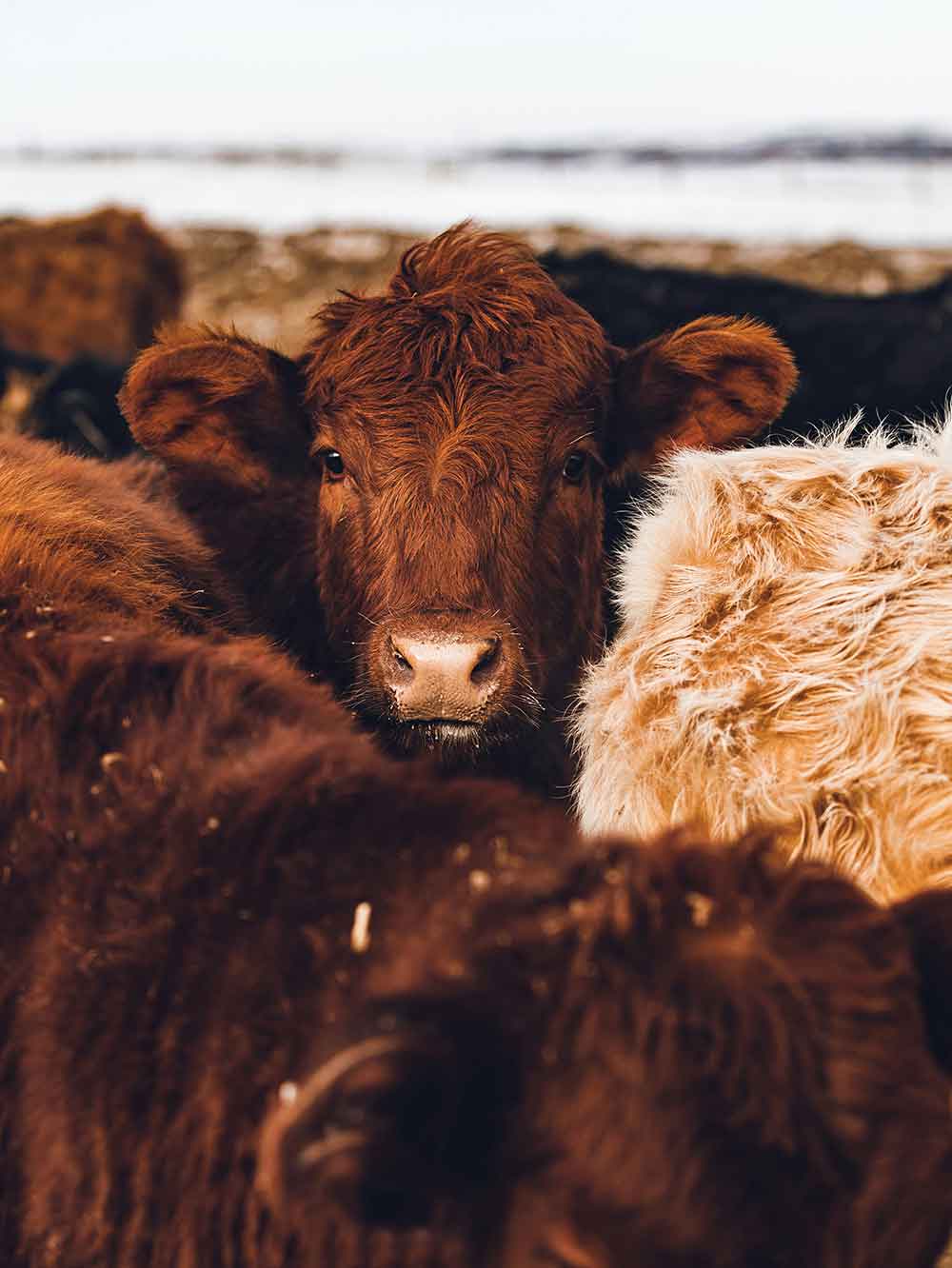
Every year, a single cow belches an average of 99kg of methane, adding to the greenhouse gases that are warming our planet.
Cows are gentle beasts that have co-existed with humans for centuries.1 Since their domestication, cows have played an invaluable role in aiding ancient humankind’s transition from hunting gatherers to a more agricultural society.2
Modern cows and bulls are the descendants of an ancient, extinct species called the aurochs, which lived two million years ago and survived until the 1600s.10 Aurochs were large, fierce animals that weighed about 1,000kg and wielded sharp horns.11
The cows that we know are gentle, peace-loving and intelligent creatures. To date, more than 1,000 breeds of cattle have been catalogued around the world.12 Each country has its own distinctive, indigenous breeds.13

One of the most well-known cow breeds is the Holstein-Friesian, considered one of the best milk-producing cows in the world.14 It was imported to the US by Winthrop Chenery, a Massachusetts breeder.15 Other cows that are prized for their milk include the Jersey (light-brown cows originating in the island of Jersey in the English Channel) and the Guernsey (found widely across the US, UK and Australia).16
India is home to the world’s largest number of milk-producing cows, with more than 50 registered breeds.17
Of these, one of the most intriguing is the tiny Punganur dwarf cattle, which has a broad forehead, a prominent hump on its back, crescent-shaped horns, stubby legs and pointed ears.18 An indigenous breed native to the southern Indian state of Andhra Pradesh, Panganur cows are known for their abundant milk supply producing up to five litres a day. This milk is nutritionally rich, higher in fat and protein than the milk of many other breeds.19 Punganar cows are also efficient grazers, consuming far fewer resources than other cattle, which makes them a big hit with farmers.20
Another Indian breed, the Nelore, made global headlines when one cow reached the jaw-dropping price of $4.8 million at an auction in Brazil.21 The cow, named Viatina-19, weighed 1,088kg at the time of the auction. According to reports, her record-breaking price was due to her “exceptional growth, strong muscling and structural correctness”. 22
The sounds that a cow or bull makes is called a ‘low’, but is often referred to colloquially as a ‘moo’.23
Mooing can be high-pitched and intense, or low and gravelly like a moan. But this isn’t just barnyard babble. These are sounds that cows use to communicate.24 Researchers have found there are unique moos for different situations. For instance, when a cow is separated from her calf, her moos are loud and high-pitched, indicating deep distress. Studies have also shown that cows use mooing to help express complex emotions and can even identify one another based on their moos, just as we can recognise the voices of our loved ones.25

Yes, mature female cattle need to give birth before they can produce milk.26 To ensure a steady supply of milk to meet global dairy demand, farmed cows are often artificially inseminated, or encouraged to conceive naturally, around three months after giving birth to maintain a regular cycle of milk production.27 On average, farm-reared dairy cows give birth to one calf per year, producing their first offspring when they are roughly two years of age.28 Calves are often separated from their mothers within a day after birth – a practice known as early separation.29 Some studies suggest that bonding between the cow and calf intensifies after 24 hours. When separation occurs after this bond has formed, it can lead to increased anxiety in both animals. Cows and calves may vocalise more, show heightened activity and often attempt to reach out of their pens.30 Although early separation may reduce short-term distress, studies have shown that prolonged contact can have positive long-term effects on the calf.3

Cows typically sleep for four hours a day. One hour of this time is spent in REM (Rapid Eye Movement), a deep phase of sleep that is restorative.32 While the amount of time a cow sleeps might seem limited, a great deal of the day is spent lying down and resting.
Cows rest for nine to 11 hours each day for around an hour at a time, especially during the night. Studies have shown that lying down is very beneficial for a cow’s digestion and helps to increase milk production.33If time is limited, cows would choose to spend time lying down rather than eating.34 You can tell if a cow is asleep by the position of her head. During deep sleep, her head and neck will be motionless.35

Researchers have observed that increasing global temperatures have impacted the sleep pattern of cows, affecting their health and milk productivity.36
A cow has only one stomach made up of four chambers, with each used in a different way to break down a cow's hard-to-digest diet of grass and vegetation.37 The first part of the stomach is the rumen. This is the largest chamber and can hold 95 litres of feed.38 The rumen has two main roles. It holds the chewed-up food and also acts as a fermentation vat, housing the many microbes used to break down food.39
From the rumen, the broken-down food is passed to the second chamber, the reticulum. This is a pouch-like structure that acts as a filter, separating the larger, more unwieldy pieces of food. The filtered food is passed into the third chamber or the omasum, which is made up of folded tissue that resembles the pages of a book. It’s the omasum’s job to absorb water before it passes into the fourth chamber. This is the abomasum and is often referred to as the “true stomach” as this is where the dietary proteins are digested and absorbed into the cow’s body.40
The fact that the rumen is home to hundreds of trillions of microbes has fascinated researchers. This microbiome, which is composed of bacteria, fungi and protozoa, is vital to the cow's health.41 One study established that a cow’s microbiome was extremely complex, colonised by over 339 microbes that could be ‘heritable’ or transmitted from parents to offspring.42 By studying the microorganisms that live in a cow’s stomach, researchers hope to improve cattle health and productivity. This could also have an added benefit for the environment.

One microbe that cattle have in their rumen is called methanogen.43 This is the microbe that produces methane as a by-product of fermentation. The methane gas is then belched out by the cow which adds to the greenhouse gases that are already warming our planet.44 One area of study hopes to disrupt the methanogen’s methane production process using a vaccine, so less is released by the cow.45 Poor digestion can also increase a cow’s methane production, so changes in feed may also help to reduce how much a cow emits. Every year, a single cow belches an average of 99kg of methane.46
Dairy cows spend an average of eight hours a day chewing cud, which is regurgitated food.47 This amounts to 30,000 individual chews, and this is part of a process called rumination, which aids digestion.
During rumination, the chewed-up cud is stored in the first part of the stomach, the rumen. The stored food is brought back up and then chewed again, mixing with saliva to form a ball-like bolus. Cows swallow this bolus and then regurgitate it, repeating the process again and again. But this is not just idle chewing. Rumination makes food easier to digest by the microbes living in the cow’s stomach.48

Cows and bulls are not naturally aggressive. External provocation or perceived threats can result in a spike of aggressive tendencies in cows and bulls.49 Aggressive traits may also crop up due to hormonal conditions. And while they don’t usually attack people, cows do have a tendency to fight among themselves, even more than bulls do.50 One reason bulls are considered more aggressive is down to the widely held belief that they charge at the sight of the colour red. However, this is just a myth. Cattle are, in fact, partially colour blind and red is one of the colours they can't see.51 When a bull charges at a matador’s cape, it's usually because it’s irritated by the movement of the material, rather than its bright colour.

Cows have a keen sense of smell and can pick up scents from many miles away.52 They have even been known to enjoy the scent of coffee.53In a study carried out by researchers from Denmark in 2017, and published in the journal Applied Animal Behavior Science, it was established that cows had a powerful sense of smell that served them in many ways. The test was conducted on individual animals, and in the farms and homes where they were housed. Researchers worked with 10 cows and 13 heifers. Coffee, orange juice and odourless tap water were presented to each of these cows in a bucket. Each odour was presented twice in a row, for two minutes each. There was a pause of two minutes, allowing the cows to sniff it. Researchers recorded the cows’ reactions, observing how long they sniffed, and whether they licked or bit at the buckets.
They found that all animals sniffed at the coffee the longest, followed by orange juice. They showed the least interest in the odourless water. They licked and bit the buckets with the coffee the most, followed by the orange juice. The test showed that cows and heifers were able to distinguish between different complex odours and that they showed a clear preference to certain scents.
A cow’s sense of smell however does a lot more for it in its daily life – it influences its reproductive behaviour.A bull can detect if a cow is ready to mate or not based on a specific compound in the cow’s urine.54 The scent of a bull’s pheromones can induce puberty in heifers.5

Cows are relatively friendly animals and research has shown that they have many traits that we humans can relate to. They play, have best friends among their herd and can be affectionate.56 These behaviours would suggest that they would be good pets.

However, there are a number of reasons why keeping cows as pets is discouraged for most people, especially if you live in a city. Cows need lots of space and plenty of grass to graze on.57 They also need access to food, fresh water, and have to be kept in large barns or sheds that protect them from extreme weather. Cows are also social animals and tend to thrive when they live in herds.58 Keeping a single cow as a pet may not be a good idea but caring for several, if you have the space and the skills required, could be as rewarding as looking after cats or dogs.
Researchers say that tweaking a cow’s diet so that digestion is more efficient – such as adding more soya to their meals, replacing grass with maize or experimenting with probiotics – could be key to limiting methane emissions.59 One more unusual suggestion is a methane-collecting backpack. Scientists from Argentina’s National Institute of Agricultural Technology tried this back in 2008. They strapped balloon-like plastic bags onto the backs of cows to measure the extent of their flatulence and its impact on global warming.60 A tube attached through the skin to the animals’ stomachs collected the gas inside the backpack, which they were then able to measure. The results were quite surprising – a standard 550kg cow produced between 800 and 1,000 litres of emissions every day. This led the scientists to infer that as much as 30% of Argentina’s greenhouse gases could be caused by their 55 million cows.

Many farmers and ranchers are now adopting an agricultural approach called precision livestock farming (PLF), which involves the use of technology to monitor and manage livestock.61 This involves reducing waste, greenhouse gas emissions and making efficient use of resources. Cattle wear sensors to track their vital signs, movement and behaviour in real-time, helping farmers to detect health issues early, improve their breeding, optimise milk output, all while monitoring their digestion closely to regulate their impact on the environment.
Yes, it seems they do! Studies have established that relaxing melodies may have a positive effect on cattle, as long as they are interspersed with periods of silence.62
Two music researchers, Adrian North and Liam MacKenzie, from the University of Leicester in the UK, put this theory to the test by playing two different kinds of music to 1,000 Holstein-Friesian cattle. Some cattle were exposed to fast-paced music of 120 beats per minute, others to slower melodies under 100bpm, while a final group experienced no music at all. The results indicated that the cows who heard music such as Beethoven’s ‘Pastoral Symphony’ or Simon & Garfunkel’s ‘Bridge over Troubled Water’ yielded 3% more milk than those exposed to faster-paced music such as Bananarama’s song ‘Venus’. They also detected a small decline in milk production from those cows who experienced excessively loud music.63
Studies have established that relaxing melodies may have a positive effect on cattle, as long as they are interspersed with periods of silence.
Cows are not an endangered species. However, there are some rare breeds whose numbers are limited, such as the Panganur cow. In 2012, there were only 2,000 of these miniature cows left in India, prompting scientists to find ways to keep this endangered breed alive.64 One method the Indian government tried to improve numbers was surrogacy. A hundred healthy and mature Panganur cows were identified as embryo donors, and 25 viable embryos were produced each year.65This seems to have had an effect, as a survey in 2022 revealed that numbers had grown to 8,806 cows.66

It’s not always possible to revive a dying breed. Pineywoods is one of the oldest cattle breeds in the southeastern United States. These speckled brown and white cows with handlebar horns are now in danger of extinction as a result of excessive crossbreeding.67 Each crossbreed, while healthy, had its own distinctive traits and characteristics that made it very different from the parent breed. As a result, only 12 purebred Pineywoods are left.68
Yes, cows do have predators. In the wild, cattle can be attacked by wolves, spotted hyenas, lions, leopards, tigers and grizzly bears.69
Death loss statistics issued by the United States’ Department of Agriculture indicates that more calves are lost to predators than adult cattle.70 A rise in the predation of cattle by wolves at Yellowstone National Park in the US. has been a cause for concern and conflict.71 Ranchers have complained that livestock management around the park has been increasingly challenging, ever since the wolf population grew.72
As a response to fear, threats from predators and even general stress and anxiety, cows rely on a technique called “bunching”, where they recognise danger and close ranks.73 Bunching begins when a dominant cow directs three or four others to form a close-knit group. Slowly, this stress and apprehension spreads to other members of the herd who start bunching as well. When faced with a predator in the wild, this technique helps the herd protect their vulnerable calves.74 Cows even have the innate ability to bunch when they’ve been raised on farms.

Ranchers are always alert to any signs of bunching as it can compromise a cow’s health and well-being, increasing stress and resulting in a loss of milk production.75
Despite their weight and size, cows are natural swimmers. That’s because they have a long body and short legs, which provides them with natural buoyancy. They also have powerful leg muscles that can carry them for miles in the water.76 On a farm beside Strangford Lough, the largest inlet in Northern Ireland, cows have to swim across the waters every year to get to the greener pastures on the other side.77
Necessity aside, cows do not swim unless they absolutely have to. Instead, they tend to prefer wet, low-lying areas and, given the opportunity, will wade into shallow water on a hot day.

Featured image © Jonas Koel | Unsplash
Fun fact image © Subtle Cinematics | Unsplash
Quick facts:
1. “What Eats Team, “What Eats a Cow?,” What Eats What?, October 8, 2024, https://whateats.com/what-eats-a-cow; Bernard M. Kissui, Department of Ecology, Evolution & Behavior, University of Minnesota, “Livestock predation by lions, leopards, spotted hyenas, and their vulnerability to retaliatory killing in the Maasai steppe, Tanzania https://cbs.umn.edu/sites/cbs.umn.edu/files/migrated-files/downloads/Ki…
2. Understanding Animal Research. “Cattle,” Accessed March 16, 2025, https://www.understandinganimalresearch.org.uk/using-animals-in-scienti…
3. ANN BIGGS OF GCI. “Cattle Factsheet,” n.d. https://education.rspca.org.uk/documents/1494931/0/FS+Cattle+Factsheet…
4. “Vechur | Dairy Knowledge Portal,” n.d. https://www.dairyknowledge.in/dkp/article/vechur; “Chianina,” n.d., https://www.thecattlesite.com/breeds/beef/44/chianina
5. Britannica Kids. “Cattle,” n.d. https://kids.britannica.com/kids/article/cattle/352928
6) World Animal Protection US. “Cow Facts,” n.d. https://www.worldanimalprotection.us/education/animal-facts/cow-facts/#…
7. “Cattle Population by Country 2024,” n.d. https://worldpopulationreview.com/country-rankings/cattle-population-by…;
8. Statista. “Cattle Population Worldwide 2012-2022,” August 9, 2024. https://www.statista.com/statistics/263979/global-cattle-population-sin…
9. Base. “Wondering How Many Cows Are in the World? Global Cattle Population Data Revealed! | Farms.com.” Copyright 2007 by My Website, n.d. https://m.farms.com/news/wondering-how-many-cows-are-in-the-world-globa…
10. Smithsonian’s National Zoo and Conservation Biology Institute. “Cow,” n.d. https://nationalzoo.si.edu/animals/cow.
11. IUCN Red List of Threatened Species. “The IUCN Red List of Threatened Species,” n.d. https://www.iucnredlist.org/search?query=cows%20&searchType=specie.
12. Rao, G Venkataraman. “Scientists Launch Study to Help Punganur Cow Back on Its Knees.” The Hindu, December 13, 2018 https://www.thehindu.com/news/cities/Vijayawada/scientists-launch-study…
Fact File:
1. Holmes, Matilda, Helena Hamerow, and Richard Thomas. “Close Companions? A Zooarchaeological Study of the Human–Cattle Relationship in Medieval England.” Animals 11, no. 4 (April 20, 2021): 1174. https://doi.org/10.3390/ani11041174
2. Madden, Robert, “The Development of Agriculture,” National Geographic, n.d. https://education.nationalgeographic.org/resource/development-agricultu…
3. Statista. “Number of Milk Cows Worldwide by Country 2023 | Statista,” October 10, 2023. https://www.statista.com/statistics/869885/global-number-milk-cows-by-c…
4. O’Brien, D. (2010, January 12). Teagasc guidelines to follow when calculating an animal’s water need. Irish Independent. https://www.independent.ie/business/farming/teagasc-guidelines-to-follo…
5. Applied Animal Behaviour Science, Volume 196, Pages 84-90, Maria Vilain Rørvang, Margit Bak Jensen, Birte Lindstrøm Nielsen, Development of test for determining olfactory investigation of complex odours in cattle, 2017 https://doi.org/10.1016/j.applanim.2017.07.008
6. Science Questions With Surprising Answers. “What Is It About Red That Makes Bulls so Angry?,” December 12, 2012. https://www.wtamu.edu/~cbaird/sq/2012/12/12/what-is-it-about-red-that-m…
7. Cooper, M. (2001, June 27). Moosic to their ears. New Scientist. https://www.newscientist.com/article/dn930-moosic-to-their-ears/.
8. Machado, T. M. P., Filho, L. C. P. M., Daros, R. R., Machado, G. T. B. P., & Hötzel, M. J. (2020). Licking and agonistic interactions in grazing dairy cows as indicators of preferential companies. Applied Animal Behaviour Science, 227, 104994. https://doi.org/10.1016/j.applanim.2020.104994
9. De La Torre, M. P., Briefer, E. F., Ochocki, B. M., McElligott, A. G., & Reader, T. (2016). Mother–offspring recognition via contact calls in cattle, Bos taurus. Animal Behaviour, 114, 147–154. https://doi.org/10.1016/j.anbehav.2016.02.004
10. The Editors of Encyclopaedia Britannica. “Aurochs | Wild, Wild Ox, Bovine.” Encyclopedia Britannica, February 24, 2025. https://www.britannica.com/animal/aurochs
11. Rawat, Roween. “From Aurochs to Burgers.” Natural History Museum, n.d. https://www.nhm.ac.uk/discover/from-aurochs-to-burgers.html
12. Buchanan, David. (2016). Breeds of Dairy Cattle (Major Bos taurus Breeds). 10.1016/B978-0-08-100596-5.00624 https://www.researchgate.net/publication/301263416_Breeds_of_Dairy_Catt…
13. Marleen Felius (September 2007). Cattle Breeds: An Encyclopedia. Trafalgar Square Publishing. ISBN 978-1-57076-381-6.
14. “Dairy Cattle Breeds | Milk Production, Domestication, List, & Facts | Britannica.” Encyclopædia Britannica, 2024, www.britannica.com/topic/dairy-cattle-breeds
15. Melissa Elischer, Michigan State University Extension. “History of Dairy Cow Breeds: Holstein.” MSU Extension, December 26, 2014. https://www.canr.msu.edu/news/history_of_dairy_cow_breeds_holstein
16. ———. “Jersey | Milk Production, Dairy Farming & Livestock.” Encyclopedia Britannica, January 20, 2025. https://www.britannica.com/animal/Jersey-breed-of-cattle; ———. “Guernsey | Dairy, Brown, Hardy.” Encyclopedia Britannica, July 28, 1999. https://www.britannica.com/animal/Guernsey-breed-of-cattle
17. Registered Cattle - ICAR- National Bureau of Animal Genetic Resources. (2024b, February 20). ICAR- National Bureau of Animal Genetic Resources. https://nbagr.icar.gov.in/en/registered-cattle/
18. Punganur | Dairy Knowledge Portal. (n.d.). https://www.dairyknowledge.in/dkp/article/punganur
19. “Punganur Cows.” 2024. PMF IAS. January 28, 2024. https://www.pmfias.com/punganur-cows-2/; “Feeding Practices of Punganur Cows Adopted by the Farmers in Four Mandals of Chittoor District of Andhra Pradesh.” The Pharma Innovation Journal. Vol. SP-11–5, 2022. https://www.thepharmajournal.com/archives/2022/vol11issue5S/PartK/S-11-…
20. ThemeMascot. “Punganur Cows - ACQ IAS Academy.” ACQ IAS, n.d. https://acqias.com/daily-news-analysis-current-affairs/Punganur-cows
21. ET Online. 2024. “Record-Breaking Nelore Cow Sold for 40 Crores in Brazil Sets New Livestock Auction Milestone.” The Economic Times. Economic Times. March 26, 2024. https://economictimes.indiatimes.com/news/india/record-breaking-nelore-…
22. ---“World’s Most Expensive Cow Sold for $4.8 Million.” The Times of India, February 9, 2025. https://timesofindia.indiatimes.com/etimes/trending/worlds-most-expensi….
23. Stand out from the herd: how cows commooonicate through their lives. (2019, December 19). The University of Sydney. https://www.sydney.edu.au/news-opinion/news/2019/12/19/stand-out-from-h…
24. Lisa Bohler, “7 Reasons Why Cows Moo and What Each Pitch Means,” AZ Animals, n.d https://a-z-animals.com/blog/7-reasons-cows-moo-and-what-each-pitch-mea…
25. *BBC News. “Cow Researchers Find Meanings Behind Moos,” December 16, 2014. https://www.bbc.com/news/uk-england-nottinghamshire-30484034
26. Hussain, Grace. “Do Cows Have to Be Pregnant to Produce Milk and Do They Feel Pain When Milked?” Sentient, October 24, 2022. https://sentientmedia.org/do-cows-have-to-be-pregnant-to-produce-milk
27. Compassion USA. “About Dairy Cows,” n.d. https://www.ciwf.com/farmed-animals/cows/dairy-cows
28. RSPCA. “Dairy Cow Welfare | RSPCA - RSPCA - rspca.org.uk,” n.d. https://www.rspca.org.uk/adviceandwelfare/farm/dairy
29. Ilona Stěhulová, Lena Lidfors, Marek Špinka, Response of dairy cows and calves to early separation: Effect of calf age and visual and auditory contact after separation, Applied Animal Behaviour Science,Volume 110, Issues 1–2, 2008, Pages 144-165, ISSN 0168-1591, https://doi.org/10.1016/j.applanim.2007.03.028 (https://www.sciencedirect.com/science/article/pii/S0168159107001220 )
30. Ilona Stěhulová, Lena Lidfors, Marek Špinka, Response of dairy cows and calves to early separation: Effect of calf age and visual and auditory contact after separation, Applied Animal Behaviour Science,Volume 110, Issues 1–2, 2008, Pages 144-165, ISSN 0168-1591, https://doi.org/10.1016/j.applanim.2007.03.028 (https://www.sciencedirect.com/science/article/pii/S0168159107001220 )
31. R.K. Meagher, A. Beaver, D.M. Weary, M.A. von Keyserlingk Invited review: A systematic review of the effects of prolonged cow–calf contact on behavior, welfare, and productivity, J. Dairy Sci., 102 (2019), pp. 5765-5783, 10.3168/jds.2018-16021 https://www.sciencedirect.com/science/article/pii/S0022030219304369
32. “Are Your Cows Getting Enough Sleep Each Night? | Animal & Food Sciences,” n.d. https://afs.ca.uky.edu/content/are-your-cows-getting-enough-sleep-each-…
33. McWilliams, C. J., Schwanke, A. J., & DeVries, T. J. (2021). Is greater milk production associated with dairy cows who have a greater probability of ruminating while lying down? JDS Communications, 3(1), 66–71. https://doi.org/10.3168/jdsc.2021-0159
34. “Are Your Cows Getting Enough Sleep Each Night? | Animal & Food Sciences,” n.d. https://afs.ca.uky.edu/content/are-your-cows-getting-enough-sleep-each-…
35. " “Do Cows Need Beauty Rest Too?,” n.d. https://www.thecattlesite.com/articles/4175/do-cows-need-beauty-rest-to…
36. “Impact of Heat Stress on Health and Performance of Dairy Animals: A Review,” n.d. https://www.veterinaryworld.org/Vol.9/March-2016/7.html
37. T. J. Hackmann1 Department of Animal Sciences, University of Florida, Strategies to Improve Rumen Microbial Efficiency, https://animal.ifas.ufl.edu/apps/dairymedia/rns/2014/hackmann.pdf
38. The ruminant digestive system. (n.d.). https://extension.umn.edu/dairy-nutrition/ruminant-digestive-system
39. T. J. Hackmann1 Department of Animal Sciences, University of Florida, Strategies to Improve Rumen Microbial Efficiency https://animal.ifas.ufl.edu/apps/dairymedia/rns/2014/hackmann.pdf
40. The ruminant digestive system. (n.d.). https://extension.umn.edu/dairy-nutrition/ruminant-digestive-system
41. Cammack, K M, K J Austin, W R Lamberson, G C Conant, and H C Cunningham. “Tiny but Mighty: The Role of the Rumen Microbes in Livestock Production.” Journal of Animal Science, January 27, 2018. https://doi.org/10.1093/jas/skx053
42. Wallace RJ, Sasson G, Garnsworthy PC, Tapio I, Gregson E, Bani P, Huhtanen P, Bayat AR, Strozzi F, Biscarini F, Snelling TJ, Saunders N, Potterton SL, Craigon J, Minuti A, Trevisi E, Callegari ML, Cappelli FP, Cabezas-Garcia EH, Vilkki J, Pinares-Patino C, Fliegerová KO, Mrázek J, Sechovcová H, Kopečný J, Bonin A, Boyer F, Taberlet P, Kokou F, Halperin E, Williams JL, Shingfield KJ, Mizrahi I. A heritable subset of the core rumen microbiome dictates dairy cow productivity and emissions. Sci Adv. 2019 Jul 3;5(7):eaav8391. doi: 10.1126/sciadv.aav8391. PMID: 31281883; PMCID: PMC6609165. https://www.science.org/doi/10.1126/sciadv.aav8391
43. Hook, Sarah E., André-Denis G. Wright, and Brian W. McBride. “Methanogens: Methane Producers of the Rumen and Mitigation Strategies.” Archaea 2010 (January 1, 2010): 1–11. https://doi.org/10.1155/2010/945785
44. CLEAR Center. “Why Do Cattle Produce Methane, and What Can We Do About It?,” April 22, 2024. https://clear.ucdavis.edu/explainers/why-do-cattle-produce-methane-and-…
45. Baca-González, Victoria, Patricia Asensio-Calavia, Sergio González-Acosta, Jose Manuel Pérez De La Lastra, and Antonio Morales De La Nuez. “Are Vaccines the Solution for Methane Emissions From Ruminants? A Systematic Review.” Vaccines 8, no. 3 (August 20, 2020): 460. https://doi.org/10.3390/vaccines8030460
46. UC Davis. “Cows and Climate Change,” January 7, 2025. https://www.ucdavis.edu/food/news/making-cattle-more-sustainable
47. K.A. Beauchemin, Journal of Dairy Science,Volume 101, Issue 6, Pages 4762-4784 “Why Do Cattle Chew Their Cud? | Animal & Food Sciences,” 2018, https://afs.ca.uky.edu/content/why-do-cattle-chew-their-cud., https://doi.org/10.3168/jds.2017-13706.
48. K.A. Beauchemin, Invited review: Current perspectives on eating and rumination activity in dairy cows, Journal of Dairy Science,Volume 101, Issue 6, 2018, Pages 4762-4784, https://www.sciencedirect.com/science/article/pii/S0022030218303023
49. Landsberg, Gary M., and Sagi Denenberg. “Behavioral Problems of Cattle.” MSD Veterinary Manual, May 27, 2014. https://www.msdvetmanual.com/behavior/normal-social-behavior-and-behavi…
50. Landsberg, Gary M., and Sagi Denenberg. “Behavioral Problems of Cattle.” MSD Veterinary Manual, May 27, 2014. https://www.msdvetmanual.com/behavior/normal-social-behavior-and-behavi…
51. Borel, B. (2012, February 6). Why Do Bulls Charge When they See Red? livescience.com. https://www.livescience.com/33700-bulls-charge-red.html
52. BC SPCA. “10 Fun Facts About Cows - BC SPCA,” January 8, 2025. https://spca.bc.ca/news/fun-facts-about-cows
53. Applied Animal Behaviour Science, Volume 196, Pages 84-90, Maria Vilain Rørvang, Margit Bak Jensen, Birte Lindstrøm Nielsen, Development of test for determining olfactory investigation of complex odours in cattle, 2017 https://doi.org/10.1016/j.applanim.2017.07.008
54. Archunan, Govindaraju, Swamynathan Rajanarayanan, and Kandasamy Karthikeyan. “Cattle Pheromones.” Neurobiology of Chemical Communication - NCBI Bookshelf, 2014. https://www.ncbi.nlm.nih.gov/books/NBK200988
55. Archunan, Govindaraju, Swamynathan Rajanarayanan, and Kandasamy Karthikeyan. “Cattle Pheromones.” Neurobiology of Chemical Communication - NCBI Bookshelf, 2014. https://www.ncbi.nlm.nih.gov/books/NBK200988
56. Millstein, Seth. “Cows Play and Have Best Friends — but Are Rarely Given the Chance.” Sentient, January 9, 2024. https://sentientmedia.org/do-cows-play
57. Miles, Daniel. “Would You Adopt a Cow? Farm Animals Deemed Surplus to Industry Needs Rehomed as Backyard Pets.” ABC News, July 20, 2023. https://www.abc.net.au/news/2023-07-14/adopt-a-cow-and-other-farm-anima…
58. Huxley, Jon N. and University of Nottingham. “Cattle Behavior and Implications to Performance and Health,” n.d. https://animal.ifas.ufl.edu/apps/dairymedia/rns/2010/6-Huxley.pdf
59. US EPA. “Sources of Greenhouse Gas Emissions | US EPA,” July 8, 2024. https://www.epa.gov/ghgemissions/sources-greenhouse-gas-emissions; CLEAR Center. “Why Do Cattle Produce Methane, and What Can We Do About It?,” April 22, 2024. https://clear.ucdavis.edu/explainers/why-do-cattle-produce-methane-and-….
60. Cow Backpacks Trap Methane Gas. (2008, July 11). https://phys.org/news/2008-07-cow-backpacks-methane-gas.html
61. Parisa Niloofar, Deena P. Francis, Sanja Lazarova-Molnar, Alexandru Vulpe, Marius-Constantin Vochin, George Suciu, Mihaela Balanescu, Vasileios Anestis, Thomas Bartzanas, Data-driven decision support in livestock farming for improved animal health, welfare and greenhouse gas emissions: Overview and challenges, Computers and Electronics in Agriculture, 2021, https://doi.org/10.1016/j.compag.2021.106406
62. Ciborowska, P., Michalczuk, M., & Bień, D. (2021). The Effect of Music on Livestock: Cattle, Poultry and Pigs. Animals, 11(12), 3572. https://doi.org/10.3390/ani11123572
63. Cooper, M. (2001, June 27). Moosic to their ears. New Scientist. https://www.newscientist.com/article/dn930-moosic-to-their-ears/
64. M. Kalyana Chakravarthi, G. Alexander Sri Venkateswara, “Performance of Miniature Panganur Catte of Andhra Praesh, India, Ekambaram Veterinary University (2017) https://www.semanticscholar.org/paper/PERFORMANCE-OF-MINIATURE-PUNGANUR…
65. Rangarajan, A.D. “Surrogacy, Key to Reviving Endangered Punganur Cows.” The Hindu, October 30, 2020. https://www.thehindu.com/news/national/andhra-pradesh/surrogacy-key-to-…
66. Sharma, Harikishan. (2024, January 16). Meet the Panganur Dwarf Cows that PM Modi Fed on Makar Sankranti. https://indianexpress.com/article/explained/punganur-cows-modi-9111523/
67. Angelique. “Pineywoods Cattle - the Livestock Conservancy.” The Livestock Conservancy, March 21, 2023. https://livestockconservancy.org/heritage-breeds/heritage-breeds-list/p…
68. Pitts, Justin B. and D. Phillip Sponenberg, DVM, Ph.D. “An Overview and History of Pineywoods Cattle: The Culture and Families That Shaped the Breed.” Edited by Marjorie Bender, Michele Brane, and Jennifer Kendall. Pineywoods Cattle. American Livestock Breeds Conservancy, 2010. https://livestockconservancy.org/wp-content/uploads/2021/09/pineywoods_…
69. Bernard M. Kissui, Department of Ecology, Evolution & Behavior, University of Minnesota, “Livestock predation by lions, leopards, spotted hyenas, and their vulnerability to retaliatory killing in the Maasai steppe, Tanzania https://cbs.umn.edu/sites/cbs.umn.edu/files/migrated-files/downloads/Ki…
70. United States Department of Agriculture, Death Loss in U.S. Cattle and Calves Due to Predator and Nonpredator Causes, 2015 https://www.aphis.usda.gov/sites/default/files/cattle_calves_deathloss_…
71. Evan. “The Threat of Reintroduced Wolves to Livestock in Yellowstone – Debating Science,” December 2, 2015. https://websites.umass.edu/natsci397a-eross/the-threat-of-reintroduced-…
72. Flörcke, Cornelia, and Temple Grandin. “Loss of Anti-predator Behaviors in Cattle and the Increased Predation Losses by Wolves in the Northern Rocky Mountains.” Open Journal of Animal Sciences 03, no. 03 (January 1, 2013): 248–53. https://doi.org/10.4236/ojas.2013.33037. https://www.researchgate.net/publication/275995578_Loss_of_anti-predato…
73. “Why Do Cows Bunch Together?,” n.d. https://www.thecattlesite.com/articles/why-do-cows-bunch-together
74. Wagdy R. El Ashmawy, Deniece R. Williams, Alec C. Gerry, John D. Champagne, Terry W. Lehenbauer, Sharif S. Aly “Risk factors affecting dairy cattle protective grouping behavior, commonly known as bunching, against Stomoxys calcitrans (L.) on California dairies, November 7, 2019 https://doi.org/10.1371/journal.pone.0224987
75. “Why Do Cows Bunch? | Ohio Dairy Industry Resources Center,” n.d. https://dairy.osu.edu/newsletter/buckeye-dairy-news/volume-26-issue-2/w….
76. Staff, Smore Science, and Smore Science Staff. “Can Cows Swim? - Smore Science Magazine.” Smore Science Magazine - Kids Science Magazine (blog), October 18, 2023. https://www.smorescience.com/can-cows-swim/
77. Richards, A. (2018, June 8). Footage shows swimming cows making bizarre annual pilgrimage across lake | London Evening Standard. Evening Standard. https://www.standard.co.uk/news/uk/bizarre-annual-pilgrimage-of-cows-sw…
Calf
Cattle; herd
None. Cows are herbivores2
Wolves are the main predators of cows. Also, spotted hyenas, lions, leopards, tigers and grizzly bears.1
20-30 years3
The is dependent on breed from as little as 0.8m to the tallest being 1.6m 4
Depending on the breed, bulls weigh from 450 to 1,800kg. Cows weigh from 360 to 1,000kg.5
Cows live in every continent except Antarctica.6
The US department of Agriculture estimated that the cattle population worldwide was around 1.5 billion in 2024.8 Of these, over a billion are cows, the female of the species.9

Every year, a single cow belches an average of 99kg of methane, adding to the greenhouse gases that are warming our planet.